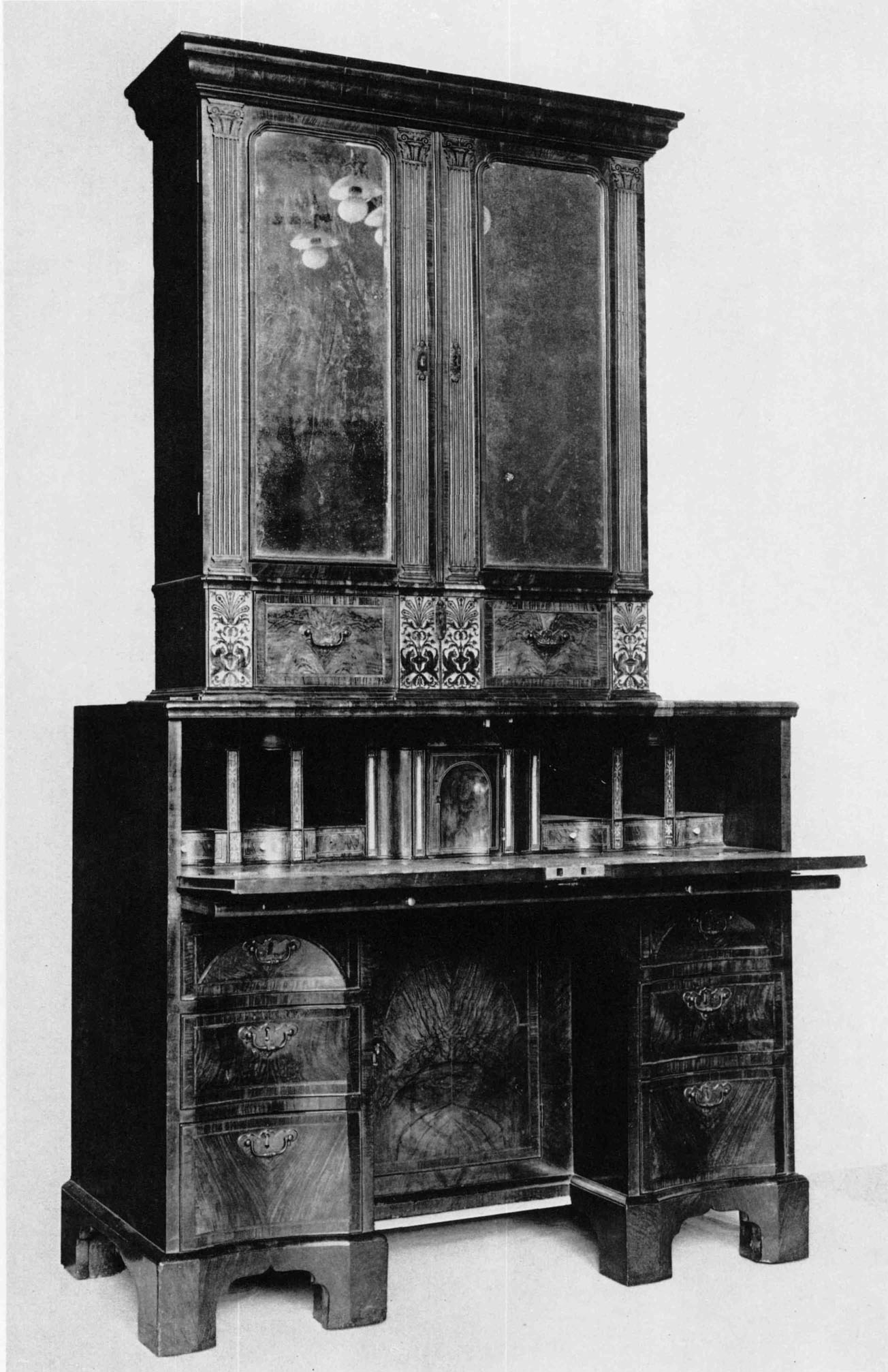Boston Blockfront Furniture
The arts are undeniably forwarder in Massachusetts-Bay, than either in Pensylvania or New York. The public buildings are more elegant; and there is a more general turn for music, painting, and the belles lettres.90
THUS Andrew Burnaby, Vicar of Greenwich, England, described Boston in 1760. He was impressed by the gentle elegance and artistic temper of the inhabitants. Among these was a group of wealthy merchants whose impressive fortunes were often reflected in a fine domestic display. The home of such a merchant, obviously a composite of native craftsmanship and imported wares, is described by John Adams in 1766: “Dined at Mr. Nick Boylstones. . . . Went over the House to view the Furniture, which alone cost a thousand Pounds sterling. A Seat it is for a noble Man, a Prince. The Turkey Carpets, the painted Hangings, the Marble Tables, the rich Beds with crimson Damask Curtains and Counterpins, the beautiful Chimny Clock, the Spacious Garden, are the most magnificent of any Thing I have ever seen.”91
Mr. Boylston and his peers surrounded themselves with articles in the latest fashion, and the ruling fashion in Boston, from about 1730 until 1765, was the style known today as Queen Anne. This style is best described by its noted proponent, William Hogarth: “There is scarce a room in any house whatever, where one does not see the waving-line employ’d in some way or other. How inelegant would the shapes of all our moveables be without it? how very plain and unornamental the mouldings of cornices, and chimney-pieces, without the variety introduced by the ogee member, which is entirely composed of waving-lines.”92
The elegance and variety Hogarth associates with the “waving-line” in The Analysis of Beauty is introduced by the curve and reverse curve of the vertical façade blocks in blockfront case furniture. It is possible, moreover, that ogee93 or “OG” was one term used in the eighteenth century to refer to this design.94
In origin and feeling, the Queen Anne style might be called “bourgeois baroque.” It is the Basilica of St. Peter at Rome domesticated, diminished, yet retaining a basic reliance upon sweeping curves, focussed and symmetrical movement. Blockfront furniture is characterized by richness, rationality, classic proportions, and an uncompromising symmetry. Spiritually antithetical as this style might appear, the Bostonians adopted and metamorphosed it into something native, comfortable, and harmonious with their lives. This style of furniture captured the imagination of New England cabinetmakers and their wealthier patrons for almost a hundred years. And judging from the number of surviving examples, blockfronts seem to have been made in great numbers.
Massachusetts blockfront furniture was made both in the urban center—Boston proper and Charlestown—and in the outlying regions of Salem, Beverly, and Concord. Its period of popularity almost spanned the century—from the 1730s until 1800, long outliving the period of Queen Anne dominance in high-style design. The blockfront appears not to have been the invention and hallmark of a single shop or cabinetmaker; it was a form which was known and imitated by many workmen. Given the number of blockfronts made, the paucity of documented examples is surprising. Their makers have remained in most cases anonymous, but half a dozen important examples are signed, or bear histories of family ownership.
The several hundred extant examples of Boston blockfronts exhibit a wide variety of forms and a healthy tendency toward experimentation on the part of the makers, yet there are certain features which are constant and which justify furniture historians in calling the Boston-area cabinetmakers a unified “school.” Materials, methods of case construction, methods of drawer construction, types of carving, varieties of feet, and decorative and design motifs are all fairly predictable within a wide range of design possibilities.
The alternate raising and depressing of vertical façade panels, which has come to be called “blocking,” serves no functional purpose. Since such a façade is time-consuming and difficult to construct, as well as wasteful of expensive mahogany, it may be assumed that these desks, chests of drawers, and dressing tables were destined for the homes of the style-conscious upper sort—the prosperous merchants and men of affairs. As little documentary evidence pertaining to the sale of blockfront furniture is known, it is difficult to assess how much more costly these items were than ordinary flat-façaded pieces; however, it is not unreasonable to assume that this large-scale decorative device cost the patron half or two-thirds again the price of the plain item (see fn. 5). That these showpieces were made for the Boston area’s most prominent citizens is attested by two documented examples—a desk bought by the wealthy merchant Josiah Quincy (fig. 91), and a high chest bought as a bridal gift for William Emerson, the prestigious clergyman of Concord and grandfather of Ralph Waldo Emerson (fig. 90).
Boston blockfronts have been largely ignored by furniture historians, partly because of a lack of such documents as account books and signed examples, but principally because they have been overshadowed by the more aesthetically impressive, better documented, more sought-after examples of the Newport school. Blockfronts appear to have been made in limited numbers as far afield as Delaware and Virginia but their principal centers of production were Boston and Newport, Rhode Island (and its stylistic satellite, Connecticut). A concerted effort has not heretofore been made to identify the characteristics of these two major regional styles, and to differentiate between them.
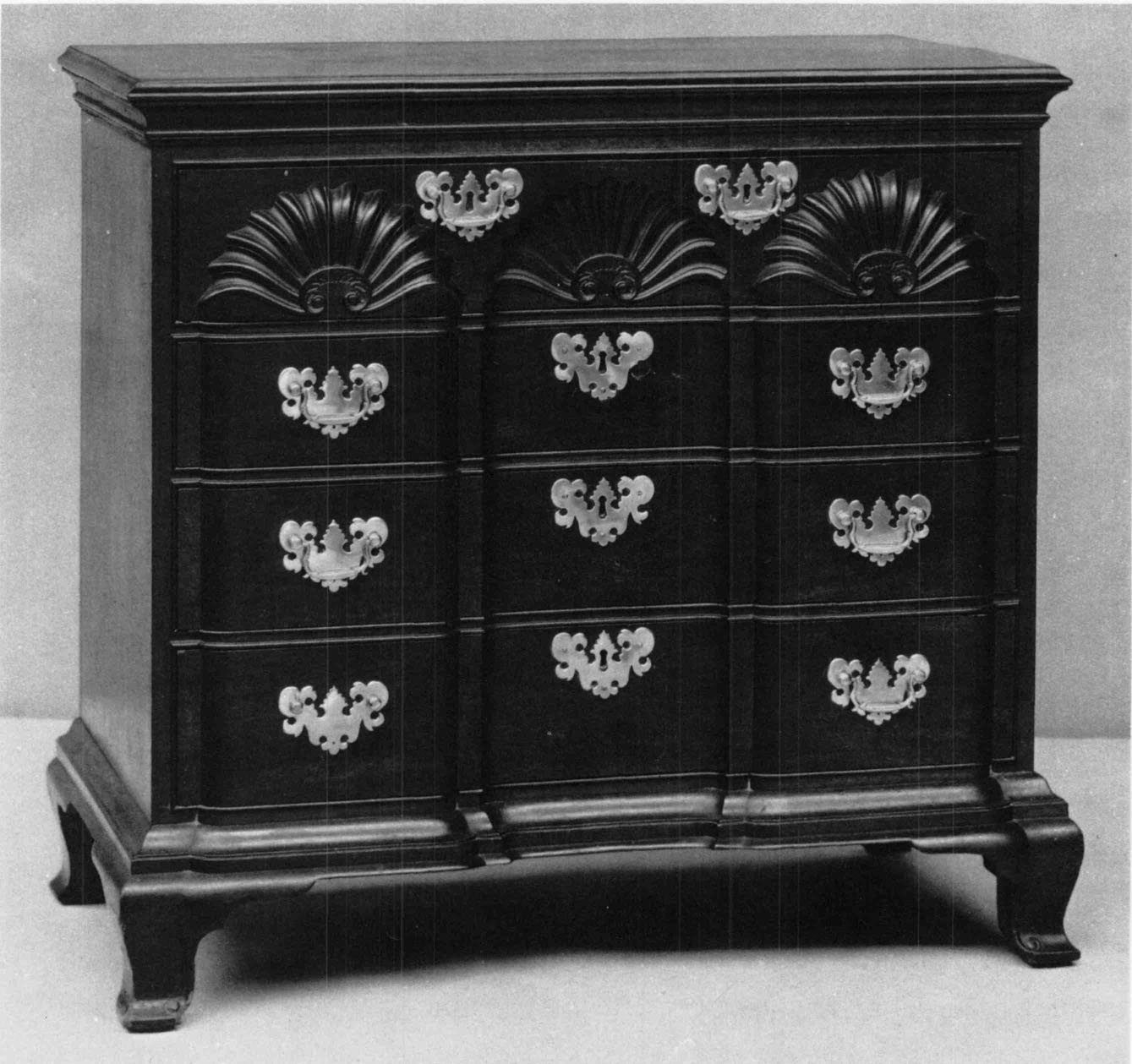
49. Chest of Drawers. Made by John Townsend, Newport, Rhode Island, 1765. Mahogany and tulipwood; h. 34½ inches, w. 36¾ inches, d. 19 inches. (The Metropolitan Museum of Art, Rogers Fund, 1927.) A typical Newport chest.
The blockfronts of Boston differ from those of Newport not only in exterior decorative elements and design features but also in standard methods of internal construction. It has long been recognized that the hallmark of Newport façades—the shell which terminates the blocking—is not found in Boston workmanship. Similarly, the rococo decorative carving used on such Boston blockfronts as the Quincy desk and bookcase does not appear in Newport design. Scholars have also recognized that the two-tiered organization of Boston desk interiors is radically different from the Newport variety. The more elusive internal habits of construction have been little explored, however, and have not been considered in conjunction with design motifs.
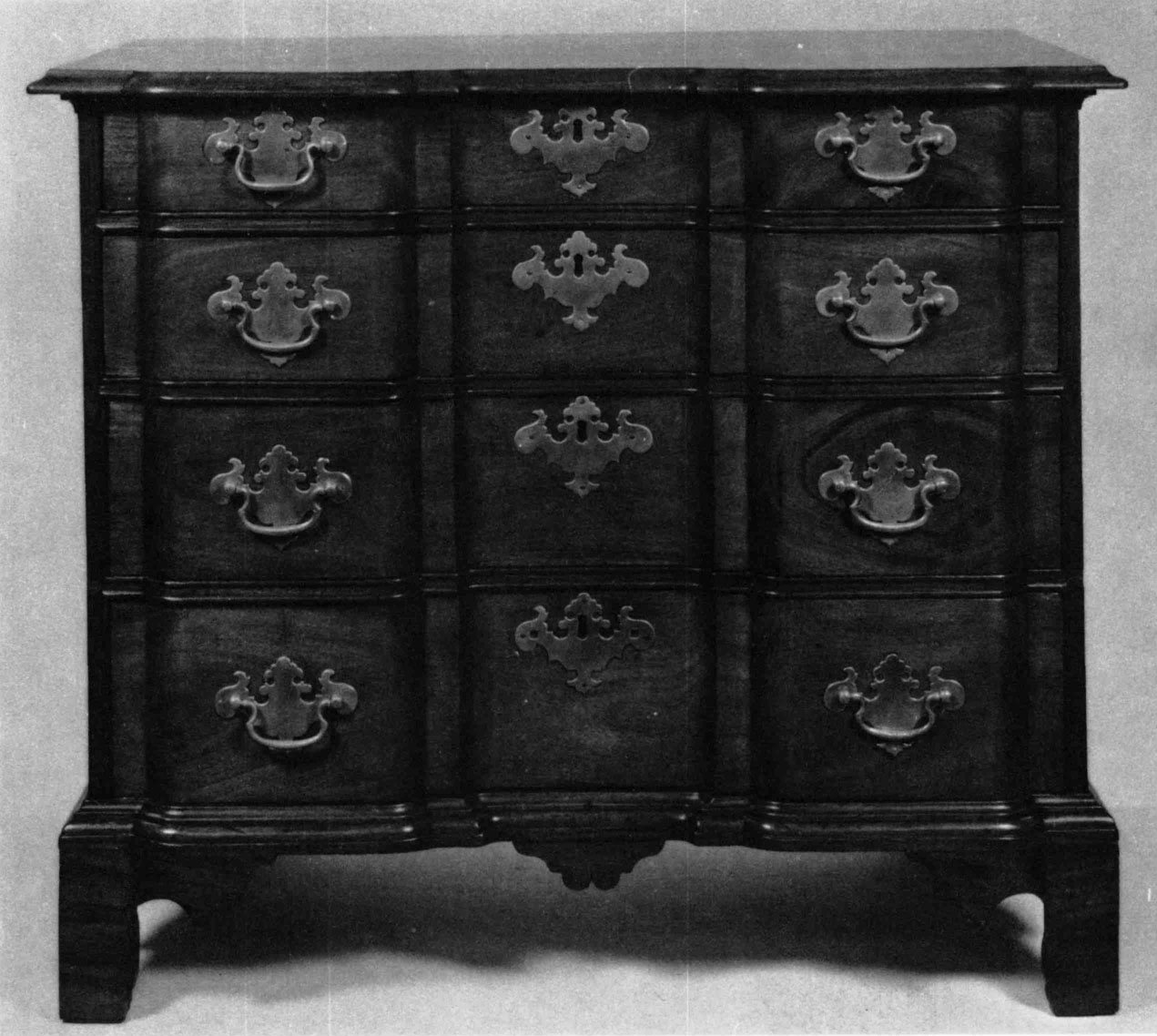
50. Chest of Drawers. Boston area, c. 1750–1790. Mahogany and white pine; h. 35¼ inches, w. 40 inches, d. 22½ inches. (The Henry Francis du Pont Winterthur Museum.) A typical Boston chest.
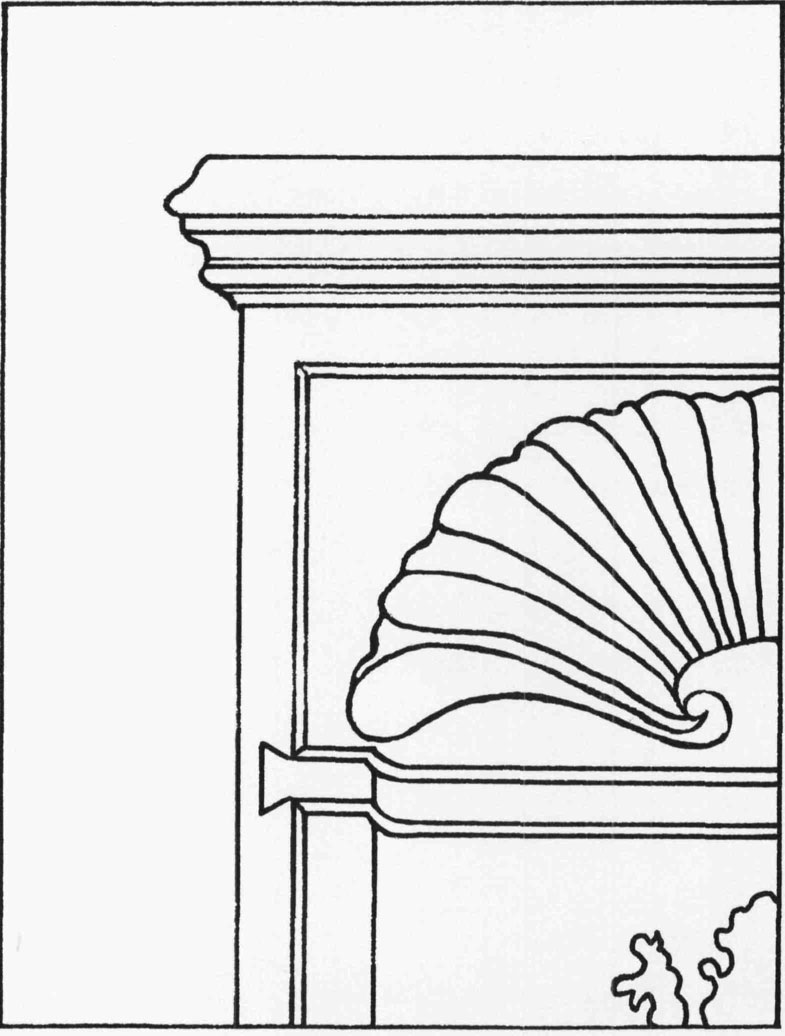
51. Detail of a Newport Chest of Drawers. This drawing shows the typical top molding, visible dovetail joint between drawer divider and side, and carved shell.
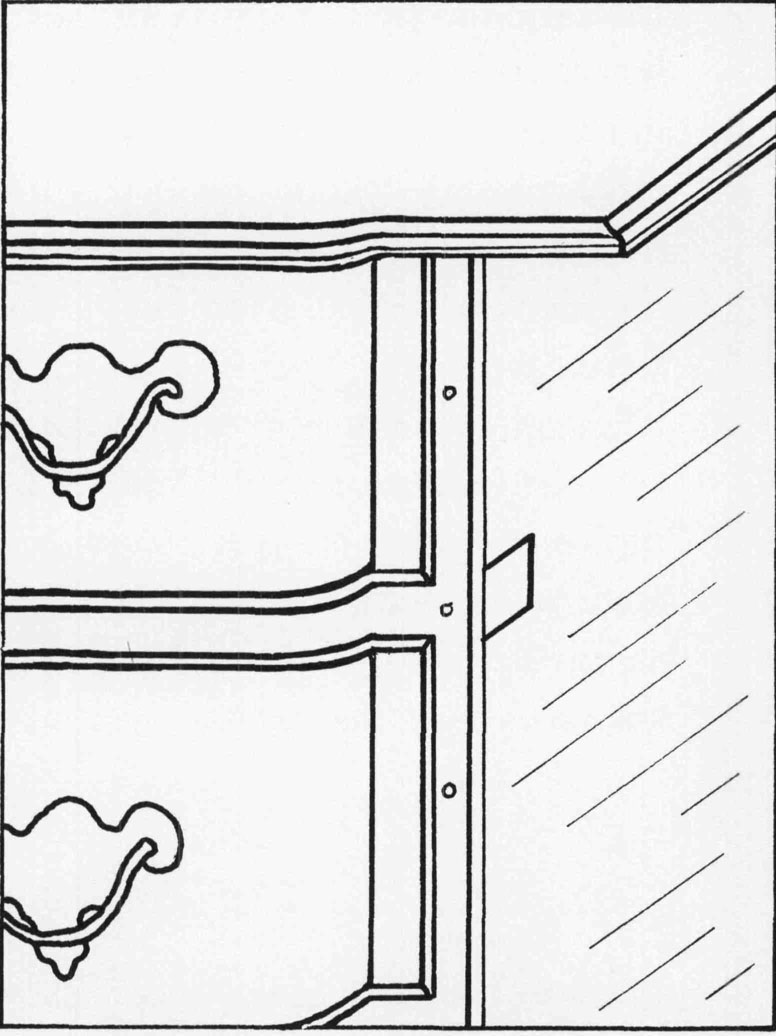
52. Detail of a Boston Chest of Drawers. This drawing shows the typical top molding, the strip covering the joint between drawer divider and side, and a more unusual feature—a run-through drawer divider (found on the Job Coit desk and bookcase [fig. 62] and the Joseph Hosmer high chest [fig. 90]).
In composition the Boston façades are much more linear and vertical than the curving modulations of the self-contained Newport blockfronts (figs. 49 and 50). The complicated top molding which frames the Newport composition and refers the eye back to the base molding has no counterpart in the light, perfunctory, terminating horizontal of Boston chests of drawers (figs. 51 and 52). As dissimilar in structure as in design, the two tops are secured in place by radically different methods. The Boston top is rather summarily jointed to the side, occasionally accompanied by an external supporting fillet. In the Newport design this fillet grows into a well-articulated molding which bands the front as well as the sides of the chest. The added height of this cove permits the Newport cabinetmaker to add two internal supporting horizontals (fig. 53) which anchor the top by means of neat dovetailed “keys,” the rear one visible from the back (fig. 54). This arrangement has no counterpart in Boston construction, where the top is usually grooved from front to back to accept the side pieces (fig. 55).
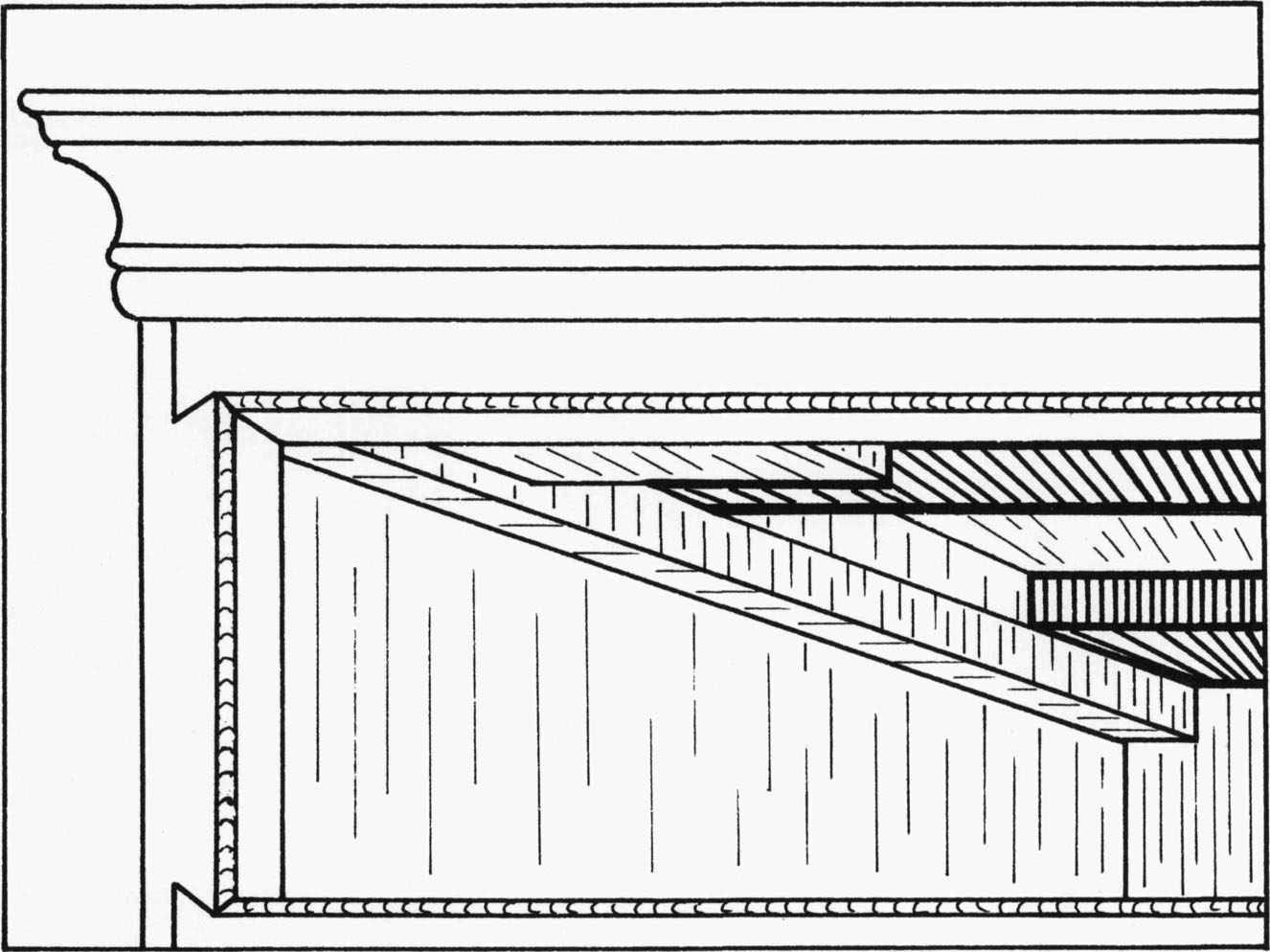
53. Detail of a Newport Chest. This drawing shows the two interior horizontal pieces of secondary wood running from side to side which secure the top.
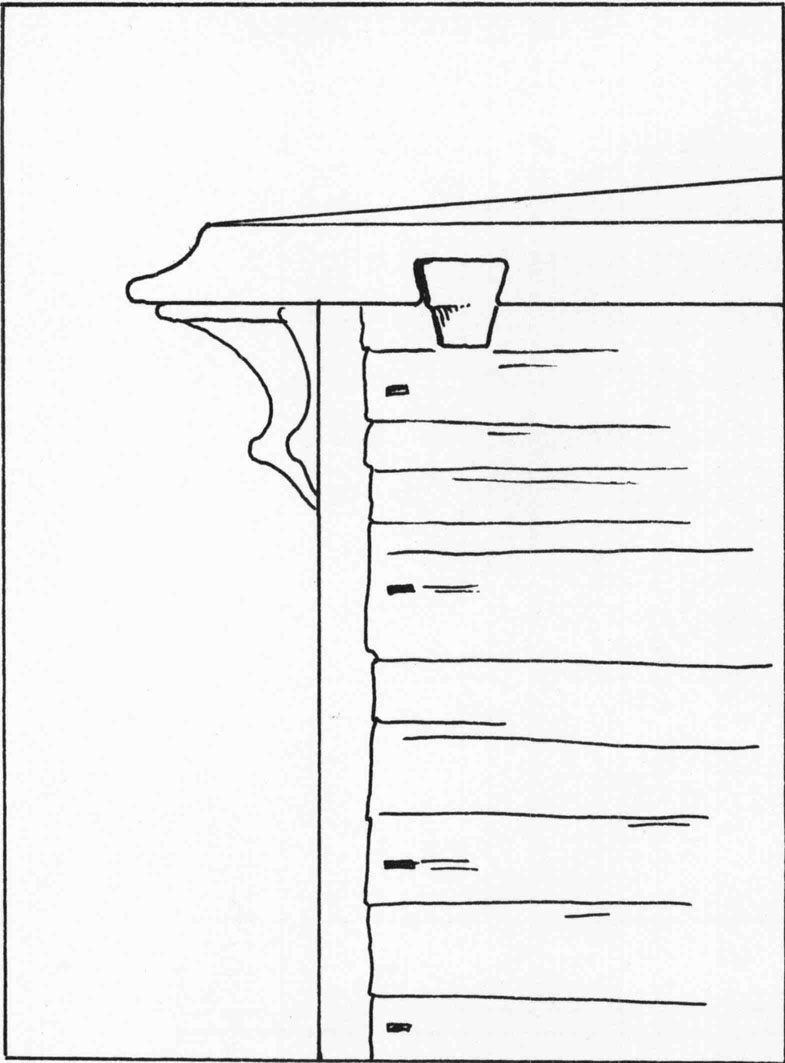
54. Detail of the Back of a Newport Chest. This drawing shows the distinctive “key” which secures the top in place, joining it to the back and to the secondary elements.
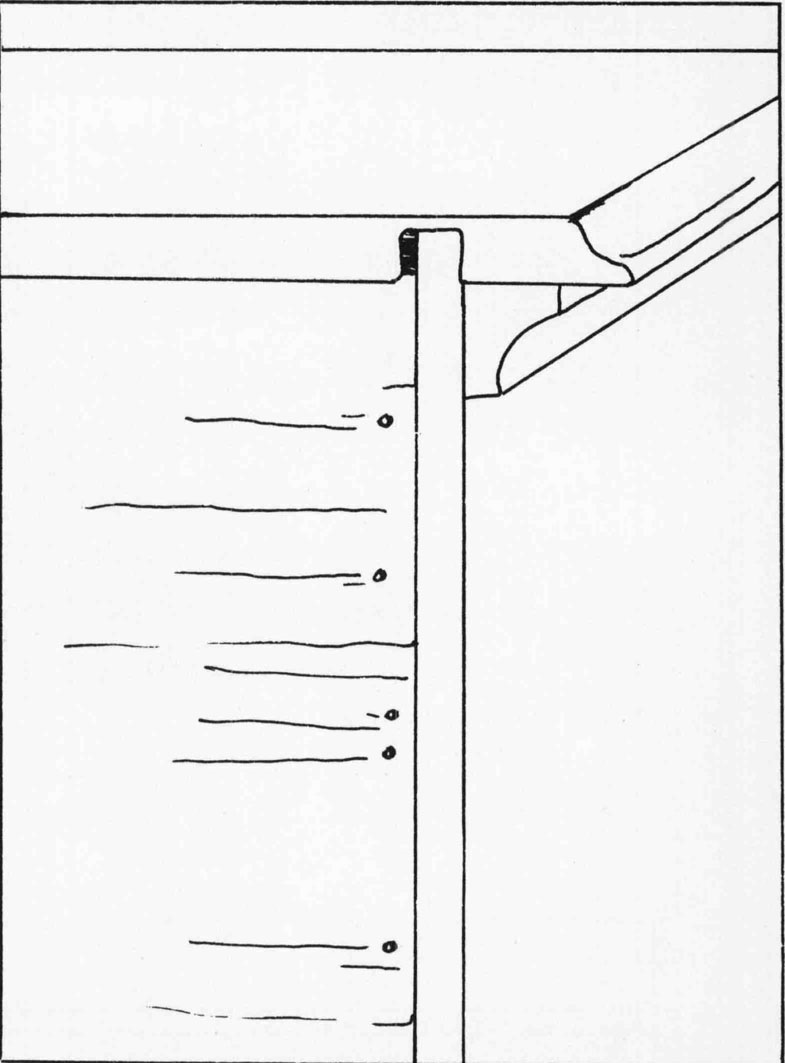
55. Detail of the Back of a Boston Chest. This drawing shows the usual means of fastening the top to the side and a more uncommon feature—an external fillet below the top.
The case bottoms are constructed with an equally marked difference (figs. 56 and 57). In Boston blockfronts the strip of mahogany from which the bottom molding is carved is secured to the secondary piece of wood on a flush plane by means of a large central dovetail behind the central concavity. In Newport, on the other hand, the piece of mahogany from which the wide base molding is carved is quite straight. Although it may have a thin supporting bar of secondary wood behind, the piece which forms the actual bottom is found at least two inches below the top of the mahogany molding, and lacks the distinctive Boston giant dovetail.
One curious feature in the otherwise meticulous design and construction practices of Newport cabinetmakers is their use of visible dovetails to fasten the drawer dividers to the sides of the case (fig. 58). Perhaps it was precisely a matter of pride in their tightness of construction which prompted this practice. It is, however, a motif which appears too often and under too many names to be the idiosyncrasy of one man or one shop.95 Boston cabinetmakers, on the other hand, follow the usual British procedure of tacking a thin strip of mahogany the length of the side piece covering the joints (fig. 59). Occasionally, as in the Job Coit desk and bookcase (fig. 62) and in less distinguished pieces of Boston furniture, the drawer dividers run clear through the front edge of the side boards and are visible from the sides of the case whether or not the façade strip is present.
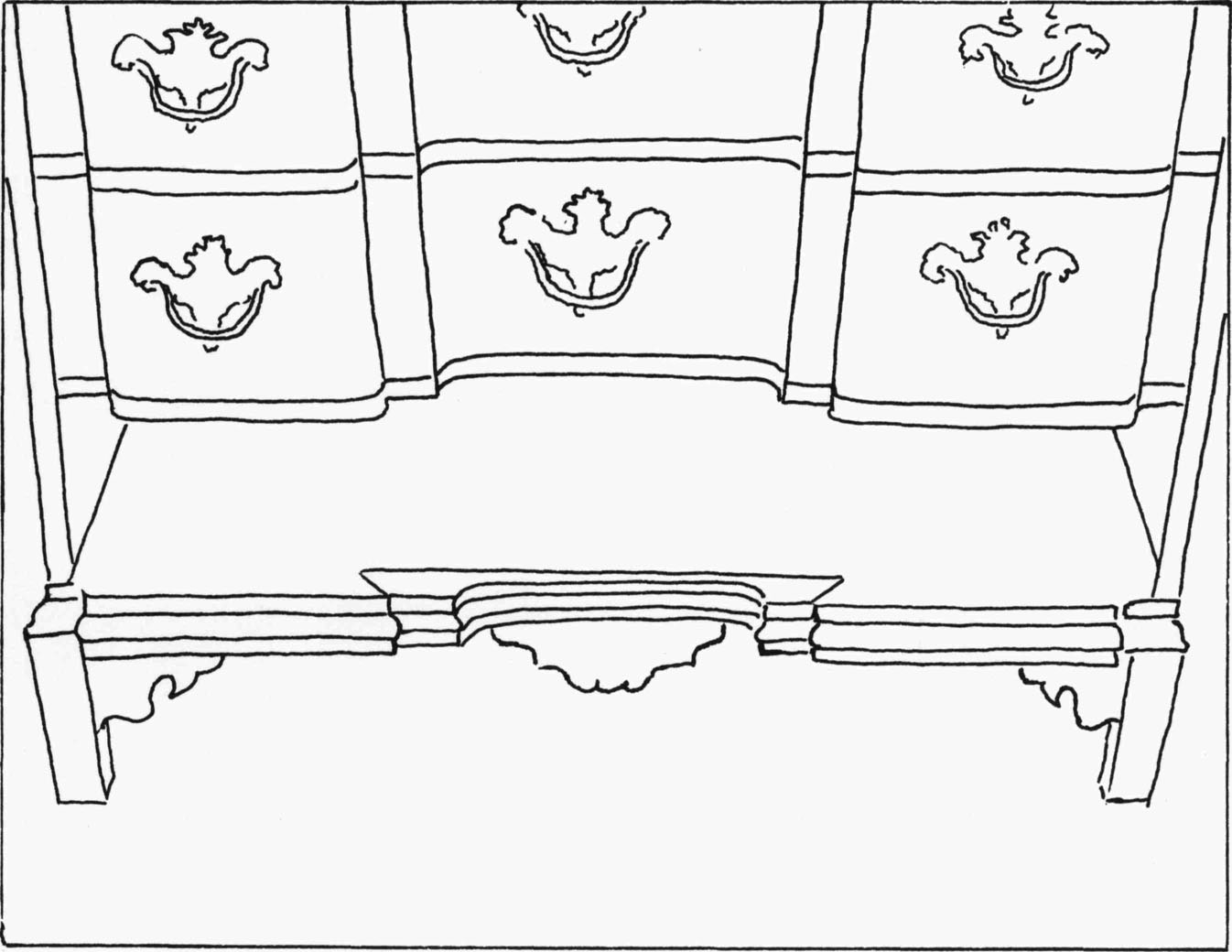
56. Detail of a Newport Chest with Bottom Drawer Removed. This drawing shows the typical form of case construction (horizontal mahogany strip behind the molding is flat in back and occasionally is supported by a small strip of secondary wood; case bottom is about two inches below the top edge of the molding).
Drawer construction also differs. In Newport the dovetails often have very thin necks, and the drawer bottoms run through the side, sandwiched in place by applied runners (fig. 58). In Boston, however, the dovetails present a much less military aspect and the drawer runs on the edge of the drawer side or on an applied runner; the drawer bottom is usually contained by the drawer side (fig. 59).
The feet found on Boston casepieces are much more varied than those found on Newport designs. The typical Boston foot, a sturdy vertical bracket (fig. 61), complements the design above, just as the swelling, involuted Newport ogee foot does its composition (fig. 60). Often, however, Boston cabinetmakers indulged in ornately carved feet, usually claw and ball, calling attention to this member in a way that would be inconsistent with Newport principles of design. Midway between the feet an ornate decorative drop often punctuates the lower outline of Boston desks and chests of drawers.
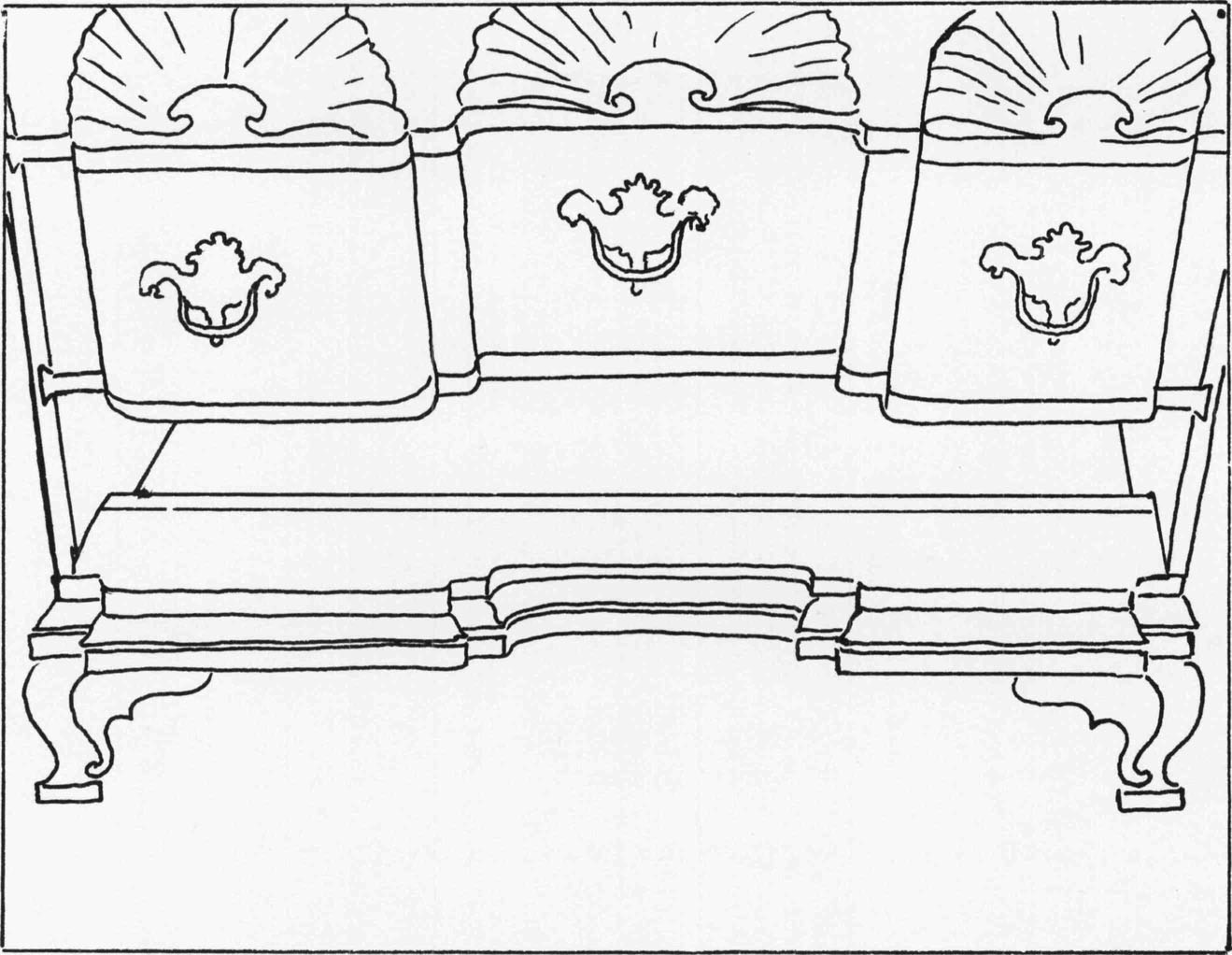
57. Detail of a Boston Chest with Bottom Drawer Removed. This drawing shows the typical form of case construction (mahogany molding joins flush with case bottom in a “giant dovetail” pattern).
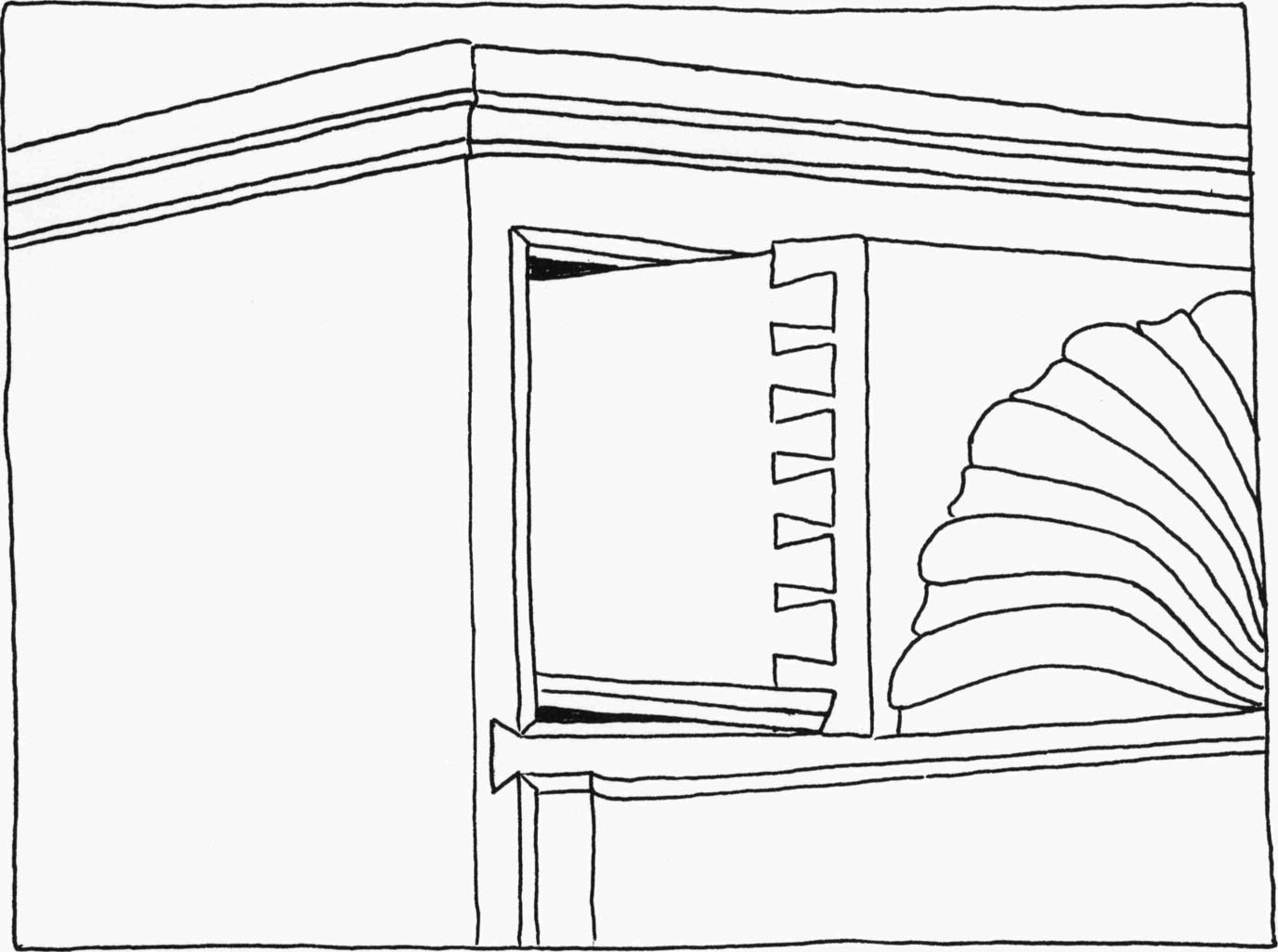
58. Detail of Newport Case and Drawer Construction. This drawing shows the typical form of drawer construction (the end of the drawer bottom is often visible from the side, with a runner applied beneath), and visible joint between drawer divider and case side.
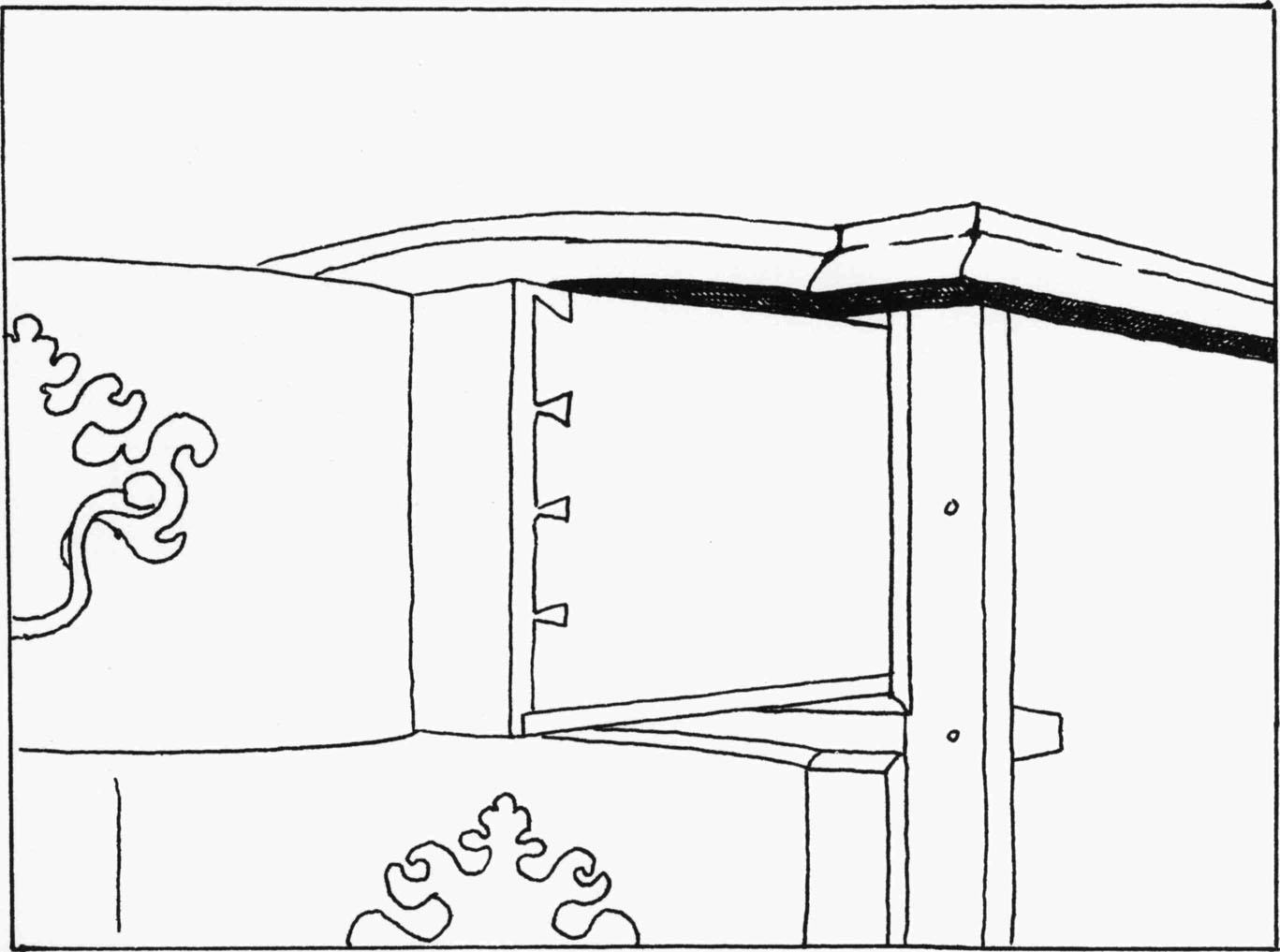
59. Detail of Boston Case and Drawer Construction. This drawing shows the typical form of drawer construction (the end of the drawer bottom is not visible from the side; a runner is often applied beneath), and strip covering joint between drawer divider and case side.
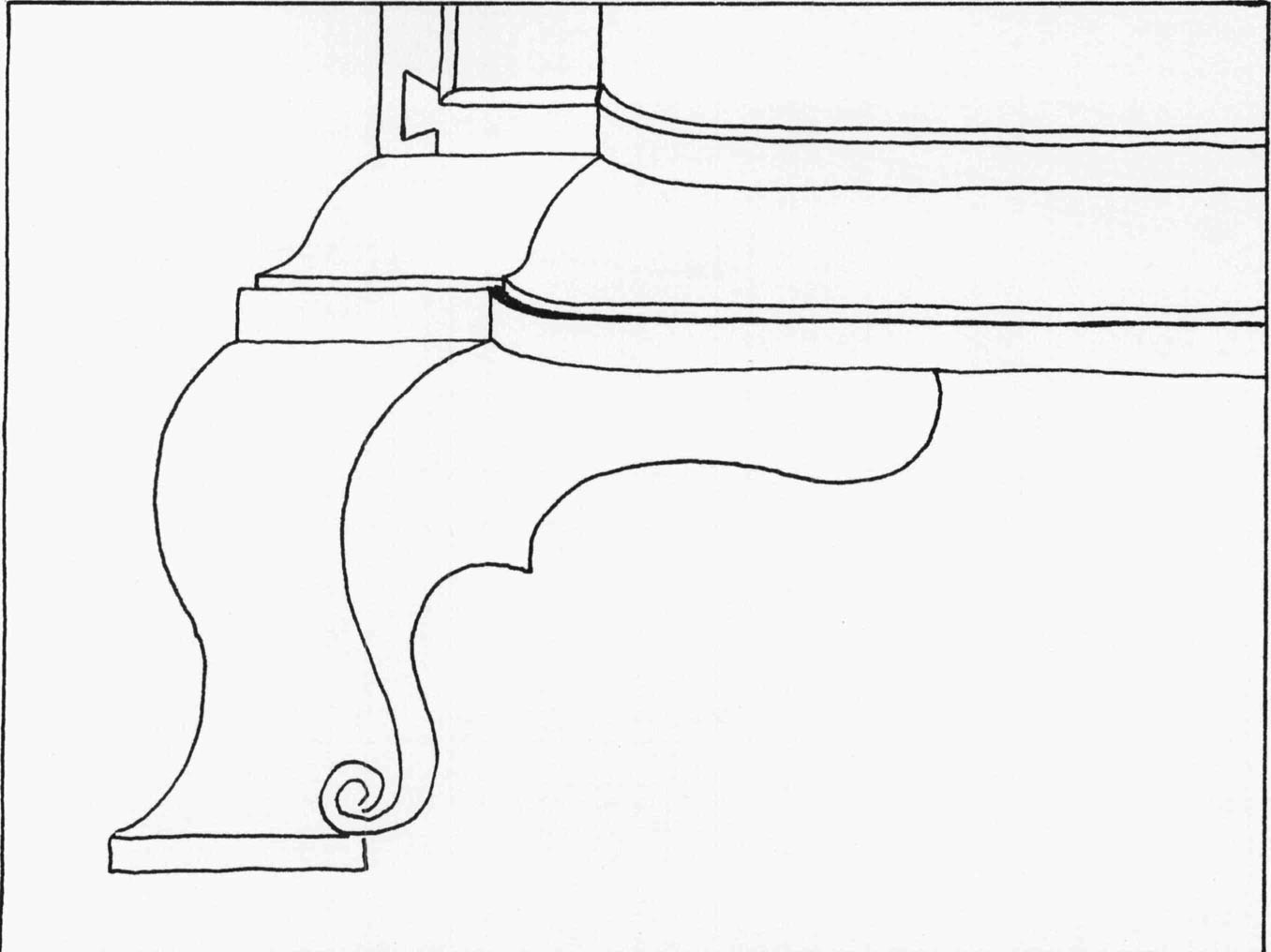
60. Detail of the Typical Newport Foot. Ogee curved feet are seen in the Boston area only on occasional pieces of Salem origin (fig. 89) which show a considerable Newport influence in several other features of design and construction.
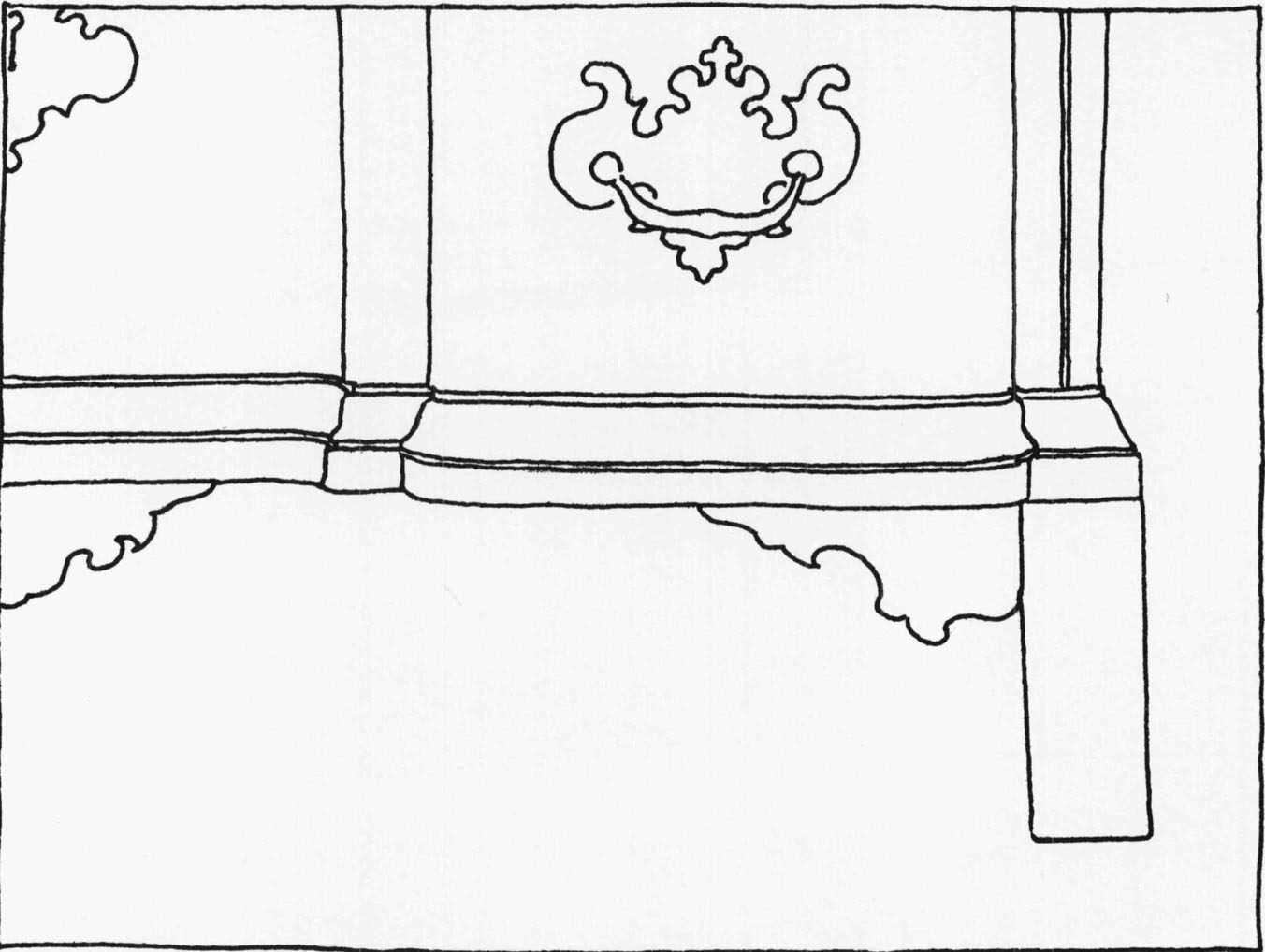
61. Detail of the Boston Foot of the Straight Bracket Type. Very common, this type of foot is almost as popular in Boston blockfronts as the ornamental claw and ball foot. A central drop is also a Boston feature.
The intention of these observations is to clarify some regional characteristics and to point to earmarks by which one may ascertain the origin of specific blockfronts. Those made in Marblehead, Concord, Charlestown, and other towns in the Boston district follow the pattern of that city’s construction and design. Those made in rural Rhode Island and Connecticut (and, incidentally, Delaware) follow the pattern of Newport design.96 Curiously, there is a group of desks from Salem which has as much in common in terms of design and construction with Newport as with Boston. (They will be discussed in detail below.) This unexpected fact brings up the question of regional characteristics—their adoption by whole schools of cabinetmakers and their distribution in that city’s shopping sphere. The phenomenon of regional characteristics is as yet little understood. Starting with signed and documented examples, however, one may at first determine and later check the structural rules and common secondary woods of a given district,97 and then trace the migration of craft practices and design motifs. The consistency with which Boston cabinetmakers used such visible motifs as the thin flat top piece on chests, dark mahogany, and such structural elements as the oversize dovetail for the bottom of the case points to a high degree of communication and exchange between competitors, or perhaps to the importance of apprenticeship training in forming both design and habits of construction. This predictability of motifs is particularly remarkable in Boston where extensive experimentation with the possibilities of the blockfront form produced more than a dozen distinct types. Apparently, the artificer’s imagination worked within a distinct and predictable set of habits.
While the Newport form of blockfront tends toward repetition of an established formula, the Boston type shows a wide spectrum of variants. Perhaps this fertile experimentation is the greatest virtue of Boston’s blockfront designs. Of the hundreds of cabinetmakers who worked in Boston during the eighteenth century, many probably made blockfronts, although only seven are known by signed or documented examples.
The earliest dated example of American blockfront furniture is the desk and bookcase signed by Job Coit and by Job Coit, Jr., and dated 1738 (fig. 62).98 It is of black walnut with secondary woods of northeastern white pine and sugar pine, executed in a polished but not extraordinary manner. Its ambitious monumental design is composed of a blocked lower façade with unusual rounded elements terminating the blocking, and an upper section with mirrored doors. The arching pediment and the cupped inlaid fans on the interior of the bookcase complement the rounded blocking below and unify the composition (fig. 63).
Not a great deal is known about the important Coit family of cabinetmakers. Their marriage and apprenticeship connections link them to several cabinetmakers whose blockfront work is known by signed examples. Yet the records are fragmentary.99 Job’s son, Captain Job Coit (1717–1745), who worked on this desk with his father, is a significant figure in the family. He married Rebecca Parkman (1696–1788), first cousin to the wealthy and influential cabinetmaker and merchant William Parkman. Young Coit was engaged in the West Indian trade and may well have seen Spanish or French architecture or furniture ornamented with undulating façades in his travels.100 He was lost at sea returning from the West Indies in 1745,101 and his widow married Jeremiah Townsend, perukemaker of Boston and New Haven.102 Jeremiah was not related to the Newport cabinet-making Townsends,103 but his family had intermarried with the Charlestown cabinetmaking Frothinghams. Three years later, Rebecca Parkman Coit Townsend’s sister-in-law, Elizabeth Coit (youngest daughter of Job Coit), married John Ingraham of New Haven.104 Two pieces of furniture, a mahogany table and a blockfront desk, are branded “J. S. INGRAHAM” and may have been made by this John Ingraham.105 He may have been a cabinetmaker apprenticed to or associated with the Coits as this marriage suggests. These marriage connections with Parkmans, Frothinghams, and Ingrahams demonstrate wide-ranging alliances within the cabinetmaking trade which Brock Jobe sees as a prerequisite to success in eighteenth-century Boston (see pp. 11–12). They also suggest connections through which design ideas were transmitted from shop to shop.
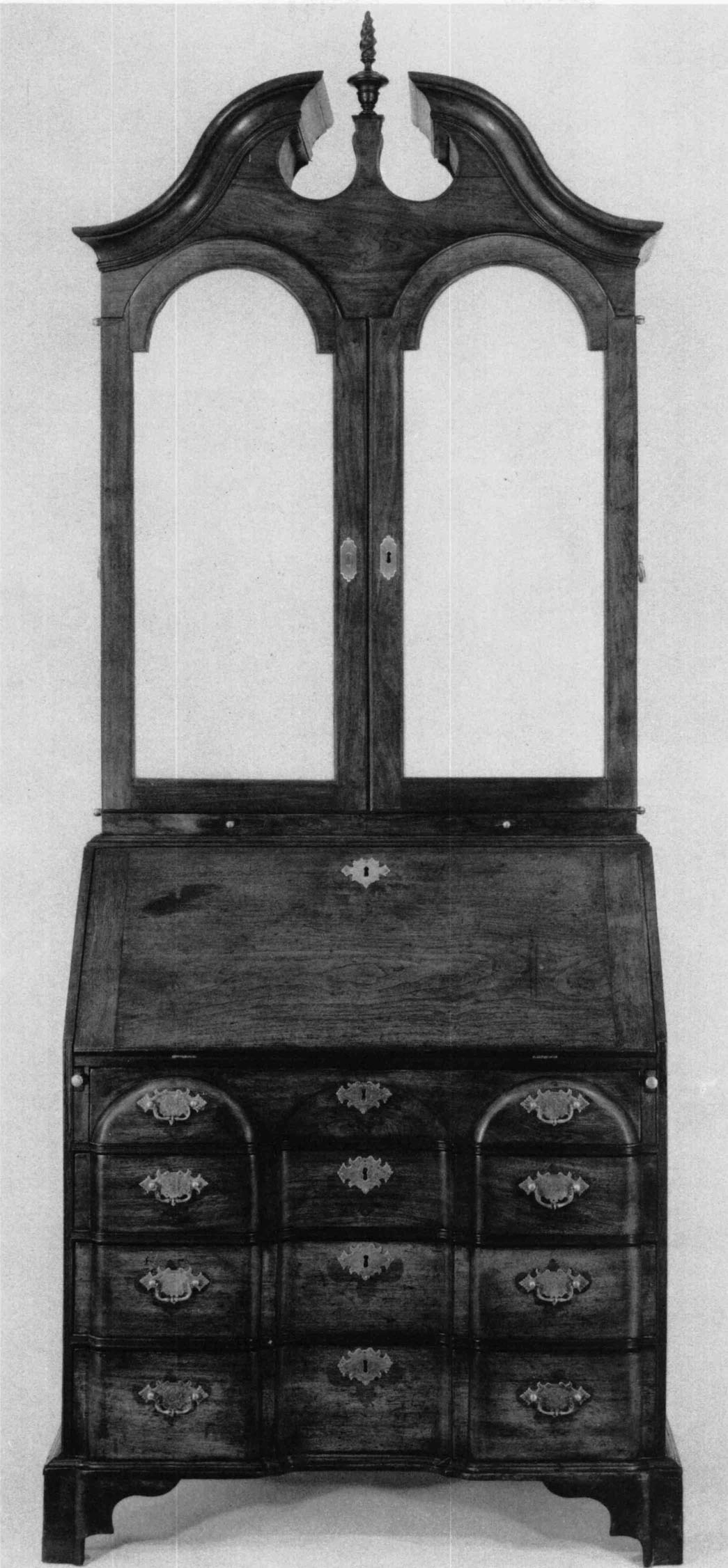
62. Desk and Bookcase. Made by Job Coit and Job Coit, Jr., Boston, 1738. Walnut, white pine, and sugar pine; h. 99½ inches, w. 39⅝ inches, d. 24⅜ inches. (The Henry Francis du Pont Winterthur Museum.) See also figs. 63 and 64. This desk and bookcase was probably constructed for Daniel Henchman (1689–1761), a stationer and merchant of Boston. One of the few blockfronts with rounded elements capping the blocking, this example is the earliest known blockfront.
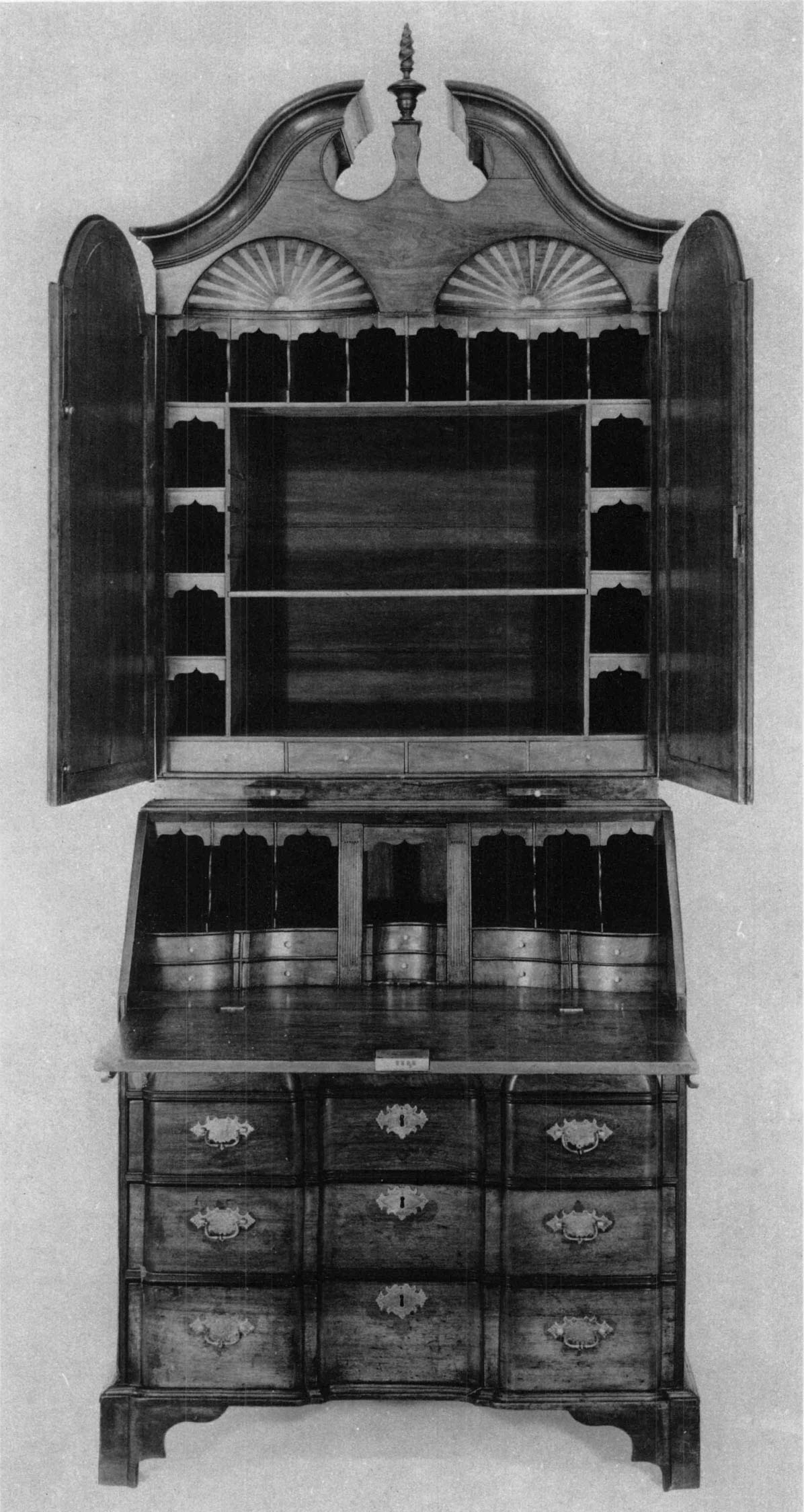
63. Interior of Desk and Bookcase. Made by Job Coit and Job Coit, Jr. (The Henry Francis du Pont Winterthur Museum.) See also figs. 62 and 64. The bookcase section displays inlaid fans.
The Coit desk and bookcase is the earliest landmark, yet known, in American blockfront history. Before the recent discovery of this desk and its signature, credit for the formulation and development of the blockfront style was given to Newport—a center which was not to become important in blockfront history until thirty years after the date of this desk.106 That this is indeed not only the earliest example known but also is probably one of the earliest examples made is indicated by internal evidence. There are elements of both design and cabinetwork that point to a struggle on the part of the maker with a new idea. It is difficult to say whether the artificer is paraphrasing a design idea which he has seen in passing or formulating his own design, but it seems likely, from some awkwardness in execution, that the former is the case.
Although the design is quite harmonious and successfully complex, the general level of finesse in the construction of this desk is rather mediocre. There are, for example, protruding drawer dividers, visible from the sides, very abbreviated columns on the document drawers, and rather perfunctory drawer construction throughout. Most significantly there seems to have been an on-the-job struggle between the cabinetmaker and his material in the crucial matter of the blocking. The line of the blocking along the bottom molding where the walnut meets the secondary wood behind has been changed and adjusted to accommodate a change in design or a faulty initial cutting (fig. 64). In either case, the craftsman is evidently not working from a familiar template, but struggling with the blocking as he works. This construction of the case bottom is not seen in other examples.
No other signed examples of Job Coit or Job Coit, Jr.’s work are known although there are several idiosyncratic earmarks both of design and construction which may point to reasonable attributions. Principally the rounded elements capping the blocks and the unusual lack of the Boston giant dovetail on the bottom of the case separate this desk from other known blockfronts.107
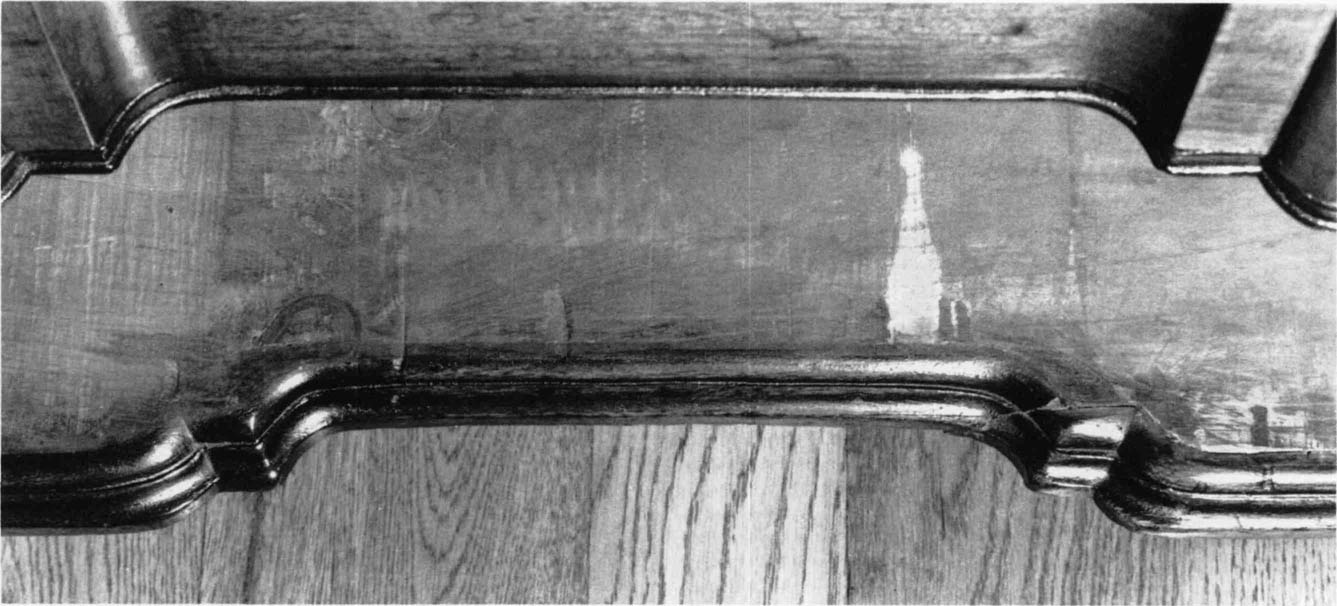
64. Detail of Desk and Bookcase Showing Unusual Case Construction. Made by Job Coit and Job Coit, Jr. (The Henry Francis du Pont Winterthur Museum.) See also figs. 62 and 63. This case lacks the typical Boston “giant dovetail” seen in fig. 57. The shaping of the bottom contour has been recut and the design adjusted for a smaller central concavity.
One piece of furniture which might be very tenuously connected with the shop of Job Coit is a small dressing table at Winterthur (fig. 65). On the back panel of this dressing table is a bold inscription, “Cushing” (fig. 66). The Cushings were an influential mercantile family in eighteenth-century Boston, and Thomas Cushing, Jr., is known to have bought furniture from Job Coit, cabinetmaker, in 1739, the approximate date of this dressing table.108 Although this speculation is very tenuous indeed (Cushing also patronized Thomas Sherburne, cabinetmaker, and Nathaniel Holmes, joiner), it is not altogether impossible. This dressing table belongs to a small group of related examples which evidently spring from the same source, all demonstrating a high quality of design.
The Cushing family dressing table is one of the most successful blockfront designs. The interplay and repetition of curves, so characteristic of the Queen Anne period, are calculated to give stature and cohesion to this rather diminutive dressing table. Each curve is scribed in one plane, and then another, and then in three dimensions. It is a very sophisticated piece of furniture, and it is astonishing to find such a fully developed design in what appears to be a very early example.
A related example at Winterthur utilizes a flattened form of blocking (fig. 67). As this and the above example have almost identical dovetailing on the drawers, and are constructed in the same peculiar manner (i.e., with the use of wooden pegs), it is probable that they were made in the same shop or by close associates.109 This close similarity is important to point out as it has been suggested that there is a regional, qualitative, or chronological difference between examples employing “rounded” and “flat” blocking. Obviously these two types were coexistent variants.
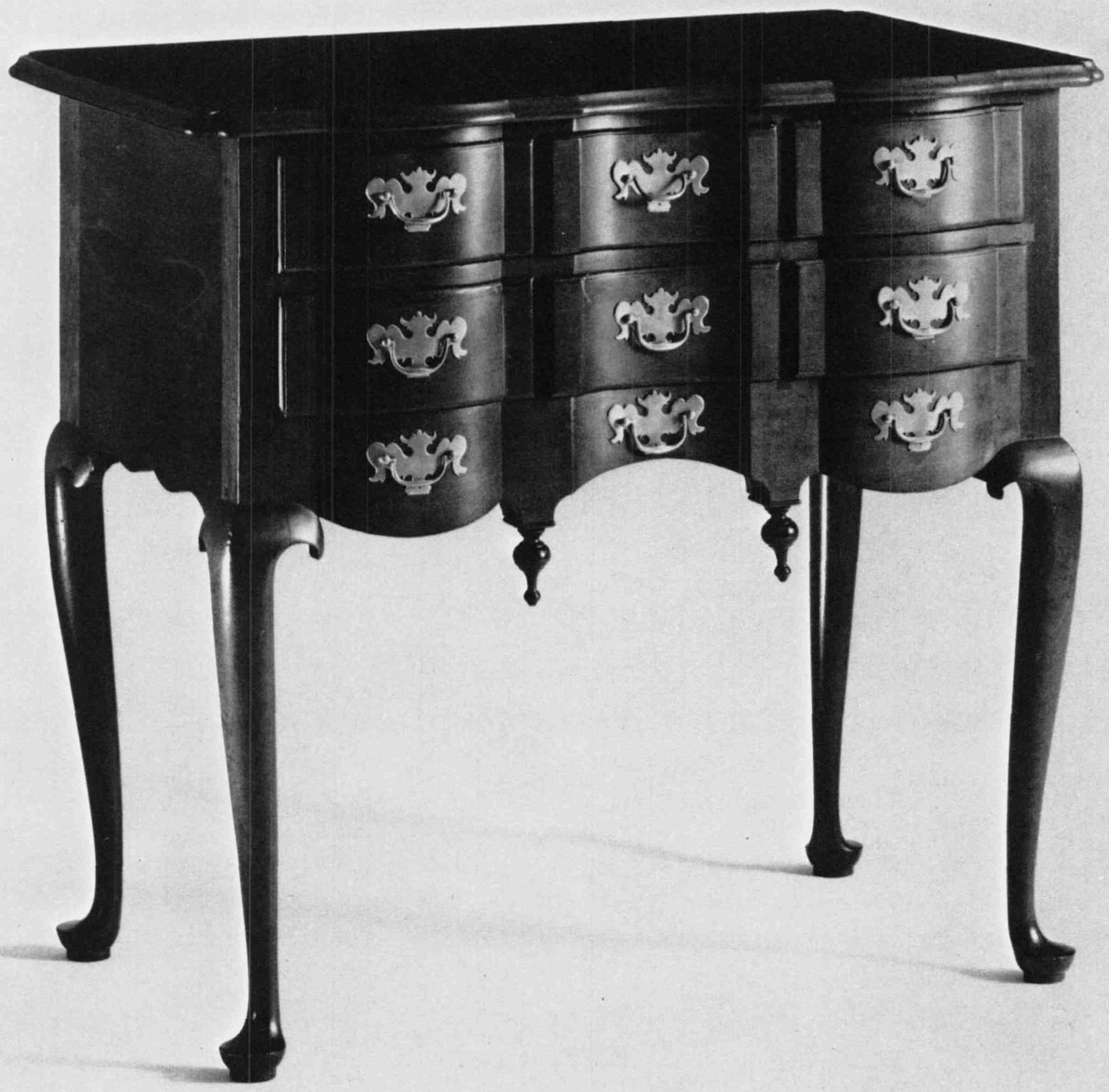
65. Dressing Table. Boston area, c. 1730–1750. Walnut and white pine; h. 31⅛ inches, w. 33⅝ inches, d. 21¾ inches. (The Henry Francis du Pont Winterthur Museum.) See also fig. 66. One of a group of handsomely designed tables, this may be from the Coit workshop.
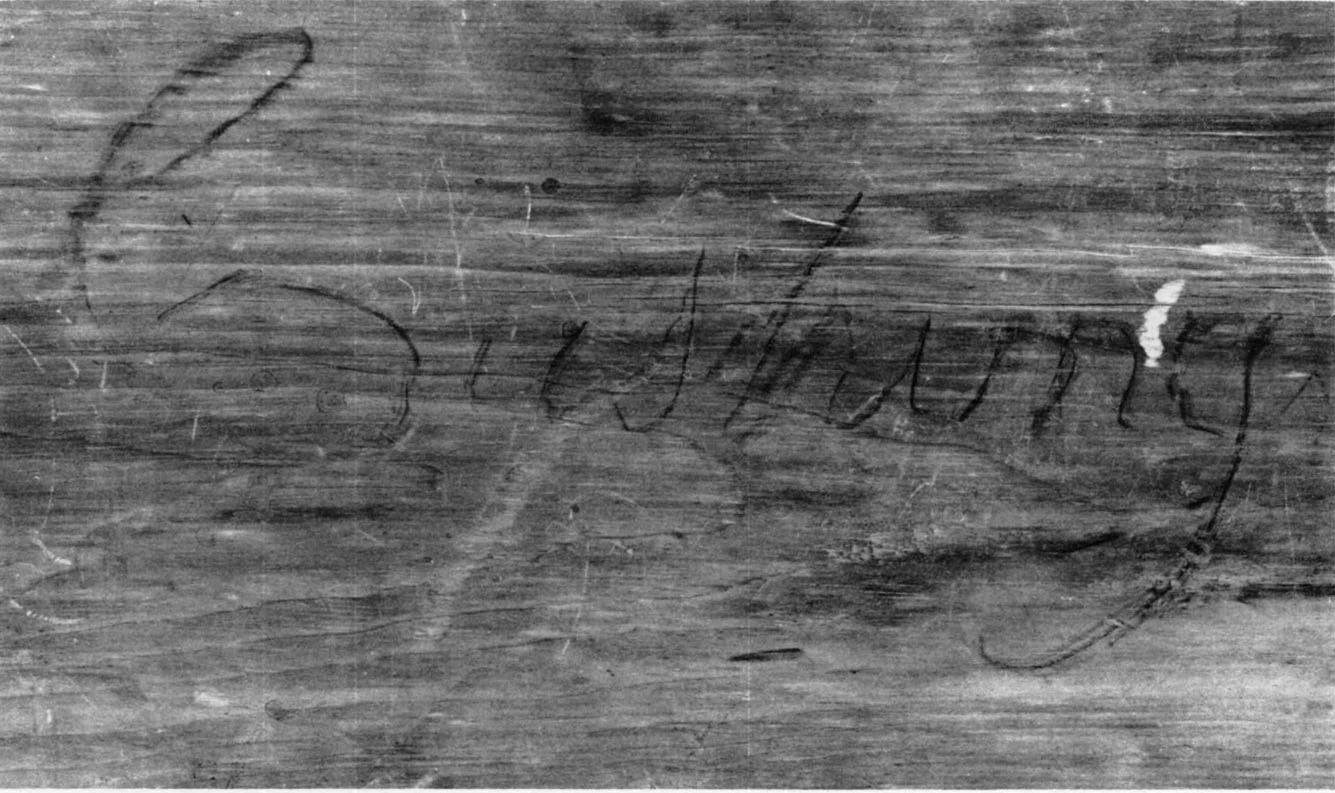
66. Detail of the Inscription “Cushing” Appearing on the Back of the Dressing Table in fig. 65. Boston area. (The Henry Francis du Pont Winterthur Museum.) Thomas Cushing, Jr., is known to have been a patron of Job Coit.
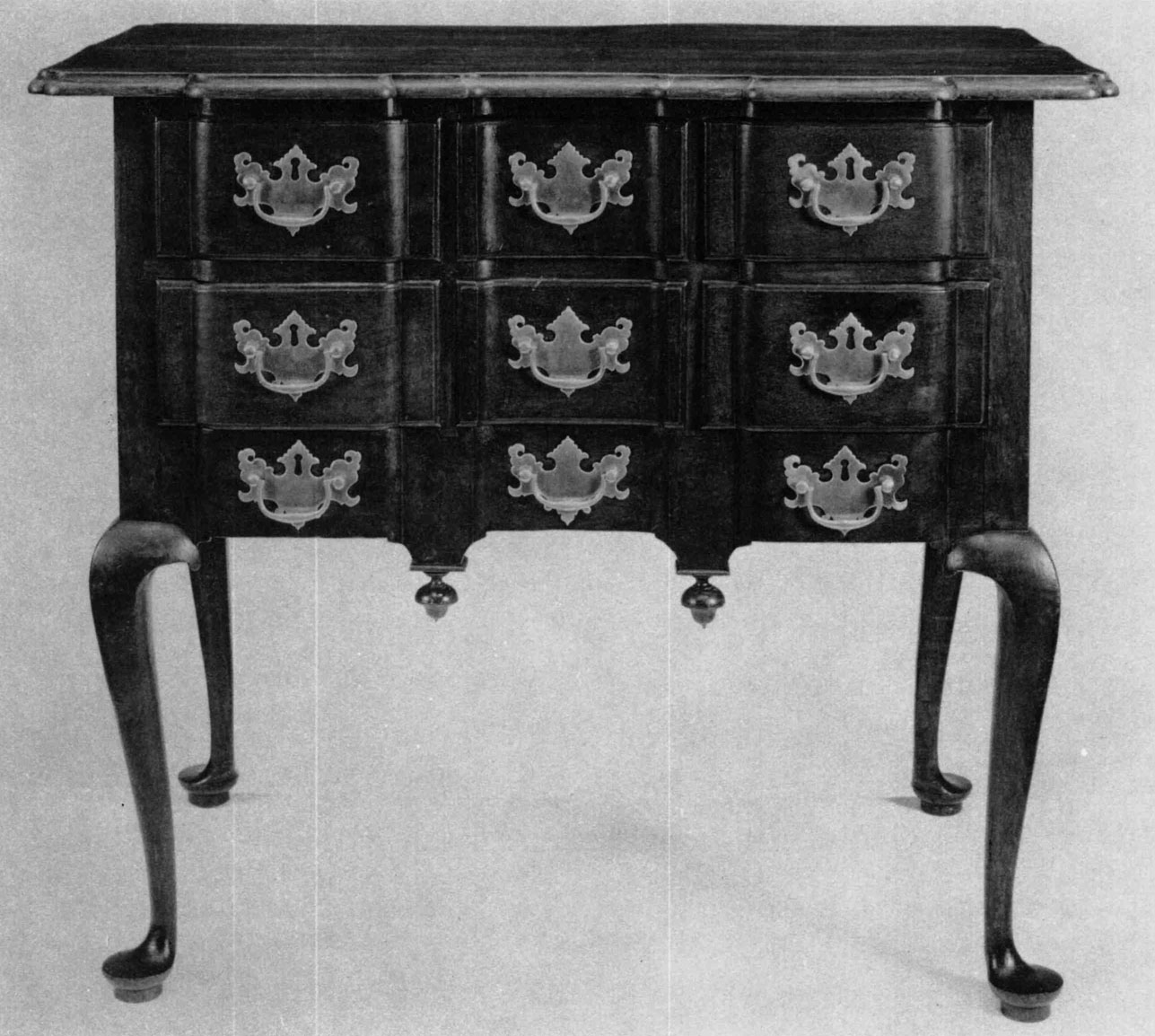
67. Dressing Table. Boston area, c. 1730–1750. Walnut and white pine; h. 32¼ inches, w. 36¼ inches, d. 21¼ inches. (The Henry Francis du Pont Winterthur Museum.)
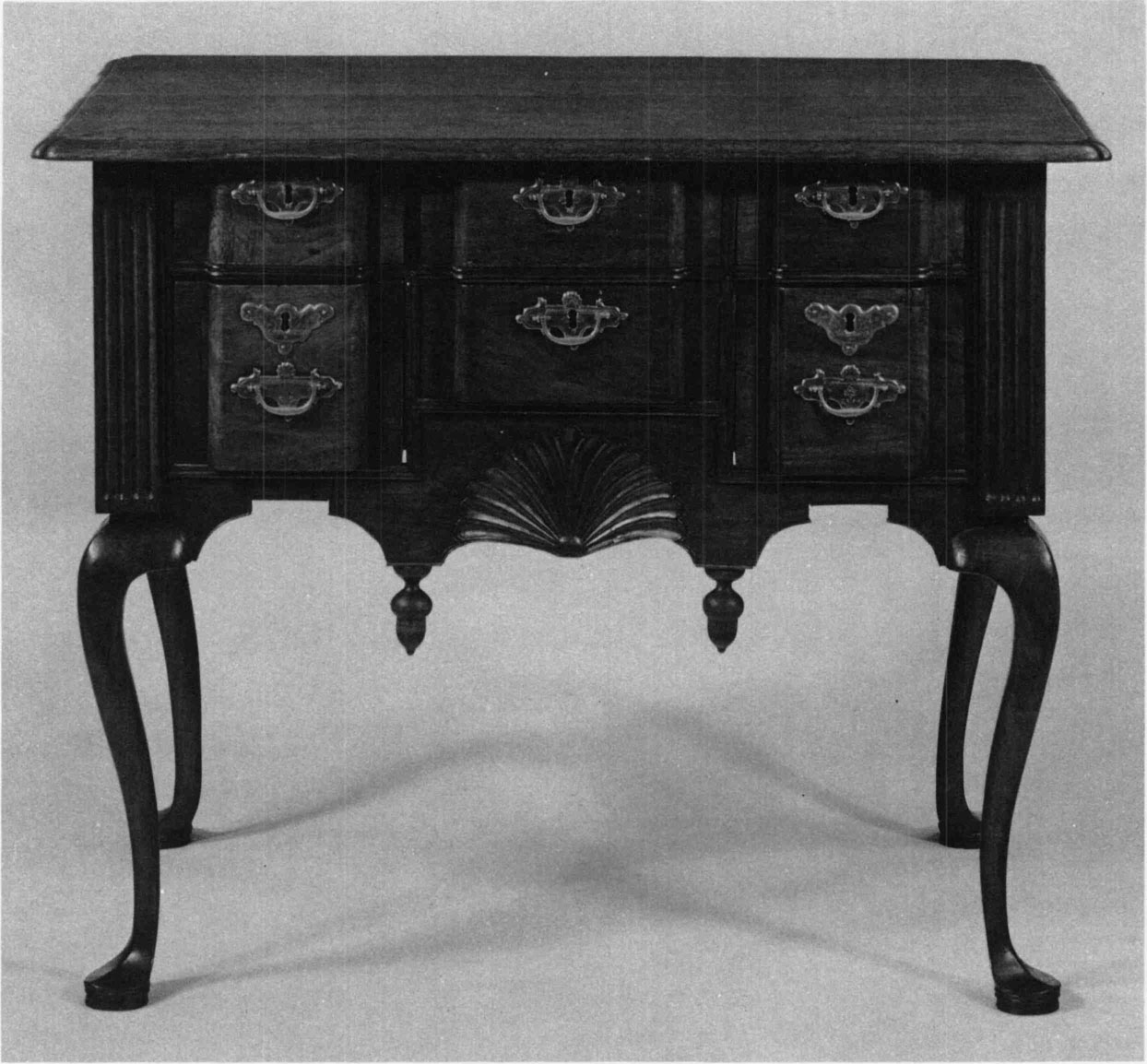
68. Dressing Table. Made by Joseph Davis, Boston area, c. 1730–1750. Walnut and white pine; h. 30 inches, w. 35¾ inches, d. 22¾ inches. (Dietrich Brothers Americana Corporation: photo, Israel Sack, Inc., New York City.) This boldly ornamented blockfront was made by an apprentice of Job Coit.
A dressing table which is related to figure 67 is illustrated in figure 68. It is an unusual and ambitious although disjointed design, and bears the signature of Joseph Davis in chalk on the bottom of a drawer. A Joseph Davis served as an apprentice to Job Coit as is attested by a signed receipt:
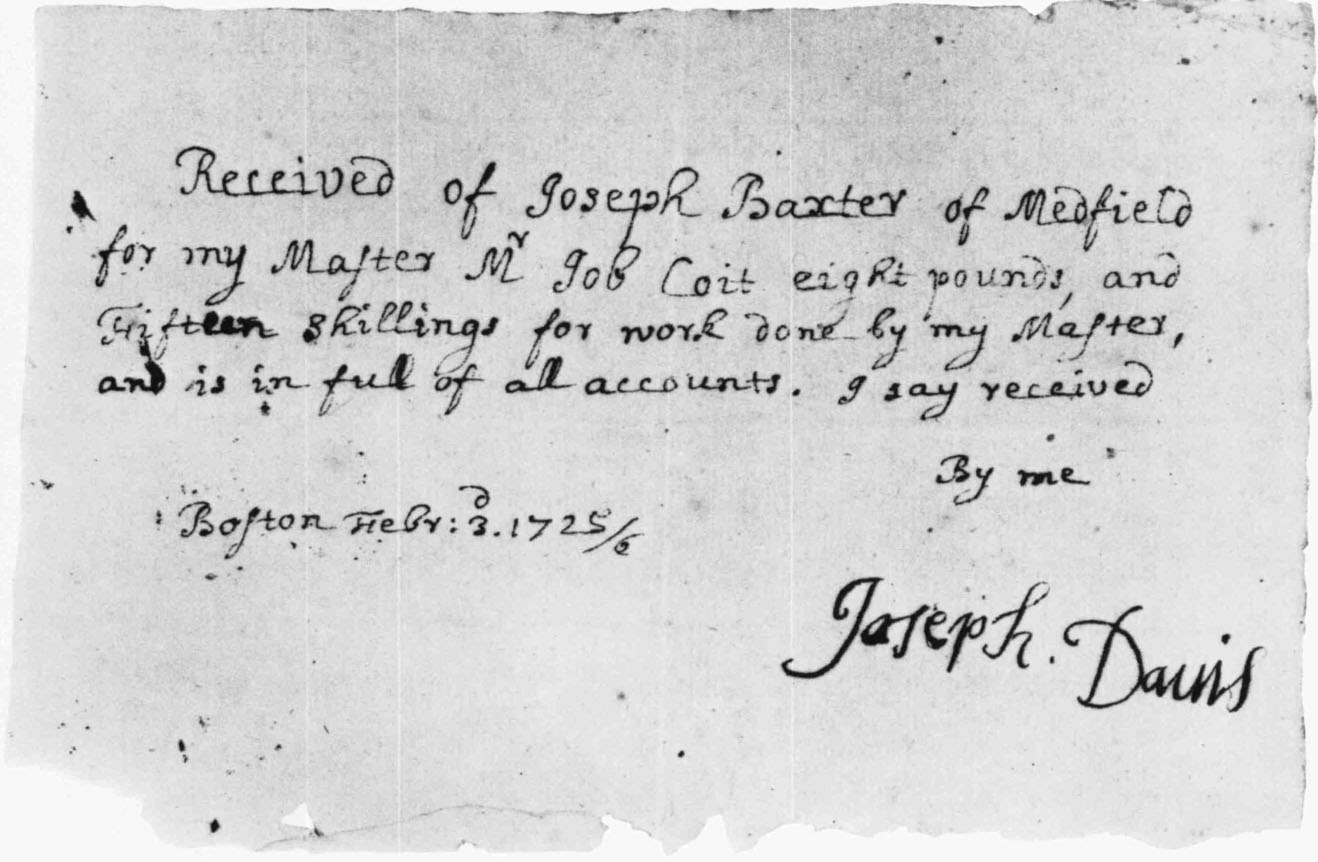
69. Receipt Signed by Joseph Davis Indicating His Apprenticeship to Job Coit. Boston, 1726. (The Henry Francis du Pont Winterthur Museum Libraries.)
Received of Joseph Baxter of Medfield for my Master Mr Job Coit eight pounds, and Fifteen shillings for work done by my Master, and is in full of all accounts. I say received
By me
[signed]
Joseph Davis
Boston Febr: 3 d. 1725/6110
The signature on the receipt (see fig. 69) and the signature on the drawer bottom are alike, establishing this piece as the work of Job Coit’s apprentice. Although its overall effect is distinctly different, certain decorative motifs on this walnut dressing table point to a relationship with the Coit desk and bookcase. The rudimentary columnar motifs, used on the document drawers of the Coit desk, here assume a major role on the façade. Still lacking the footing and capitals which seem to be required by the fluted shaft, their rather embarrassed interpretation of classicism dominates the façade. The top of the dressing table is inlaid with a central star and corner darts which recall the inlaid fans on the interior of the Coit bookcase.111
Joseph Davis must have been nearing the termination of his apprenticeship when he received the payment in 1726 for Coit’s work, for he was married on January 1, 1728, to Sarah Parsons of Gloucester. He was working on his own as a cabinetmaker in Boston in March of 1733, but there is no further record of his residence in Suffolk County after this date.112
The Coit-Davis relationship is the only known case in this period in which the work of a master craftsman and his apprentice are known by signed examples. That they were pioneers in the long-lived tradition of blockfront design cannot be doubted, although there were probably quite a few other Boston-area cabinetmakers experimenting with the form concurrently. The shortcomings in their cabinetwork and their difficulties with design may perhaps be excused in consideration of the early date of their work. However, there are contemporary Boston examples which achieve technical and aesthetic excellence (figs. 70 and 71).113 What other cabinetmakers Coit could have trained remains a matter of speculation, but it might be inferred that the movement toward stylistic and technical excellence in blockfront design is not to be looked for in the work of Joseph Davis. His work exhibits the tendency toward abbreviation and strange invention which is the mark of country and simple city furniture. The products of succeeding generations of Boston cabinetmakers show a conscious stylishness, a studied use of “correct” classicism, curves and proportion which indicate an antecedent more sophisticated than Davis.
Unfortunately, most of the makers of Boston blockfronts did not sign their products. Nor did they leave such notations on appropriate case parts as “bottom,” “left side,” “center front,” which enable the patient student of calligraphy to sort out the makers of Newport blockfronts. Perhaps the lack of these notations (omnipresent in Newport work) indicates a smaller shop unit in Boston where such communication with fellow-workmen was unnecessary.
Despite the paucity of dated examples of Boston blockfronts after the 1738 Coit desk and bookcase, the many types fall into distinct groups which can be arranged—on the basis of stylistic features—into a roughly chronological sequence. Some—like the above—can be connected to a single shop or area. Others were made by many different known craftsmen, and still other groups are completely anonymous.
One of the most unusual of the anonymous groups of Boston blockfronts is the chest-on-chest illustrated in figure 72. Its distinguishing features are a curious pediment, old-fashioned chest of drawers-with-doors upper section, and uncommon secondary woods (figs. 72 and 96). There are three known examples of this type.114 The use of doors in front of the upper set of drawers and the presence of a very baroque pediment imply an early date—probably the 1740s.
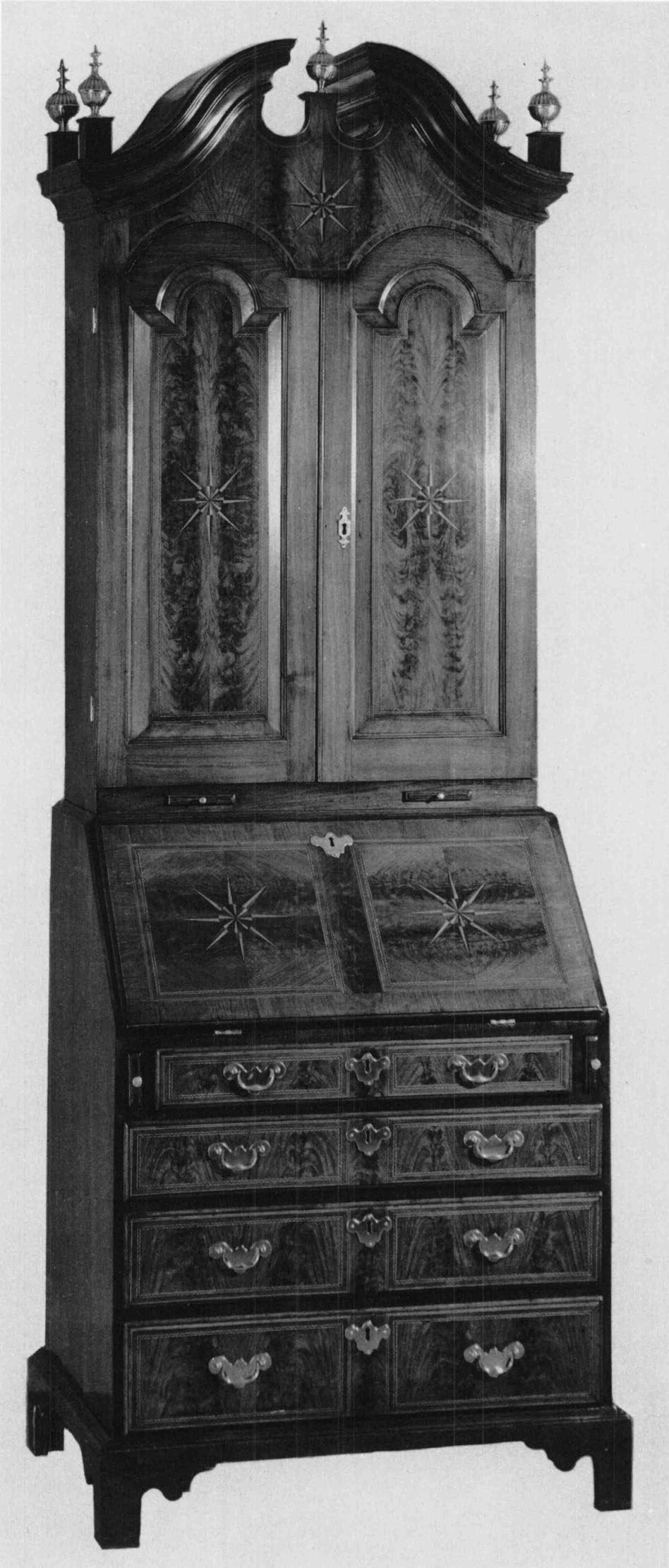
70. Desk and Bookcase. Boston, c. 1720–1740. Walnut, white pine, and maple; h. 88½ inches, w. 29⅝ inches, d. 20½ inches. (Museum of Fine Arts, Boston, M. and M. Karolik Collection, 39.176.) See also fig. 71. This desk and bookcase descended in the Avery, Greenough, and Townsend families of Boston. It exhibits motifs such as the inlaid “compasses” which are found in abbreviated form on the top of the contemporary Joseph Davis dressing table.
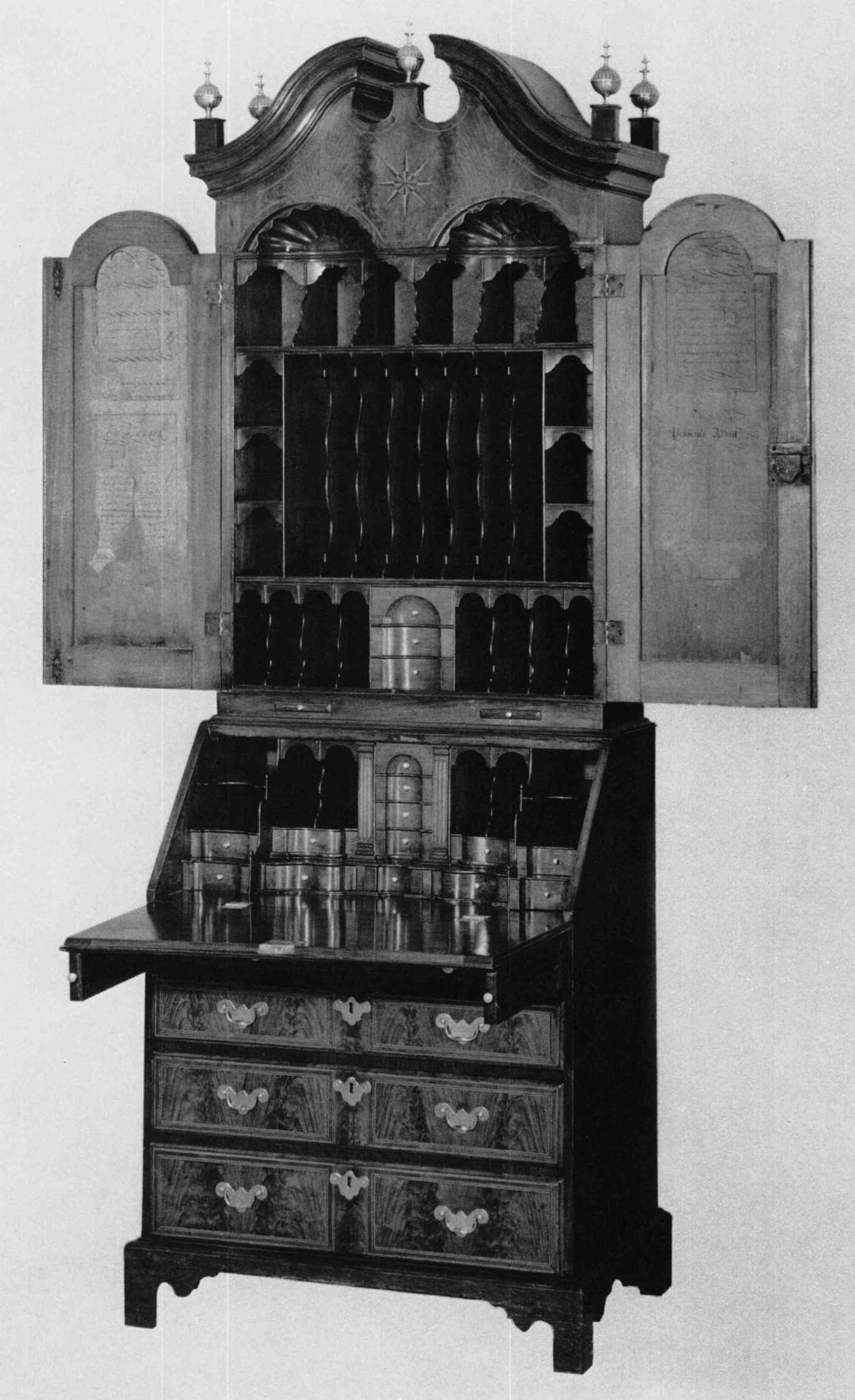
71. Interior of Desk and Bookcase. Boston. (Museum of Fine Arts, Boston, M. and M. Karolik Collection, 39.176.) See also fig. 70. Such motifs as the shells above the bookcase section and the fluted pilasters in the desk interior are found in abbreviated form in the contemporary Coit desk and bookcase.
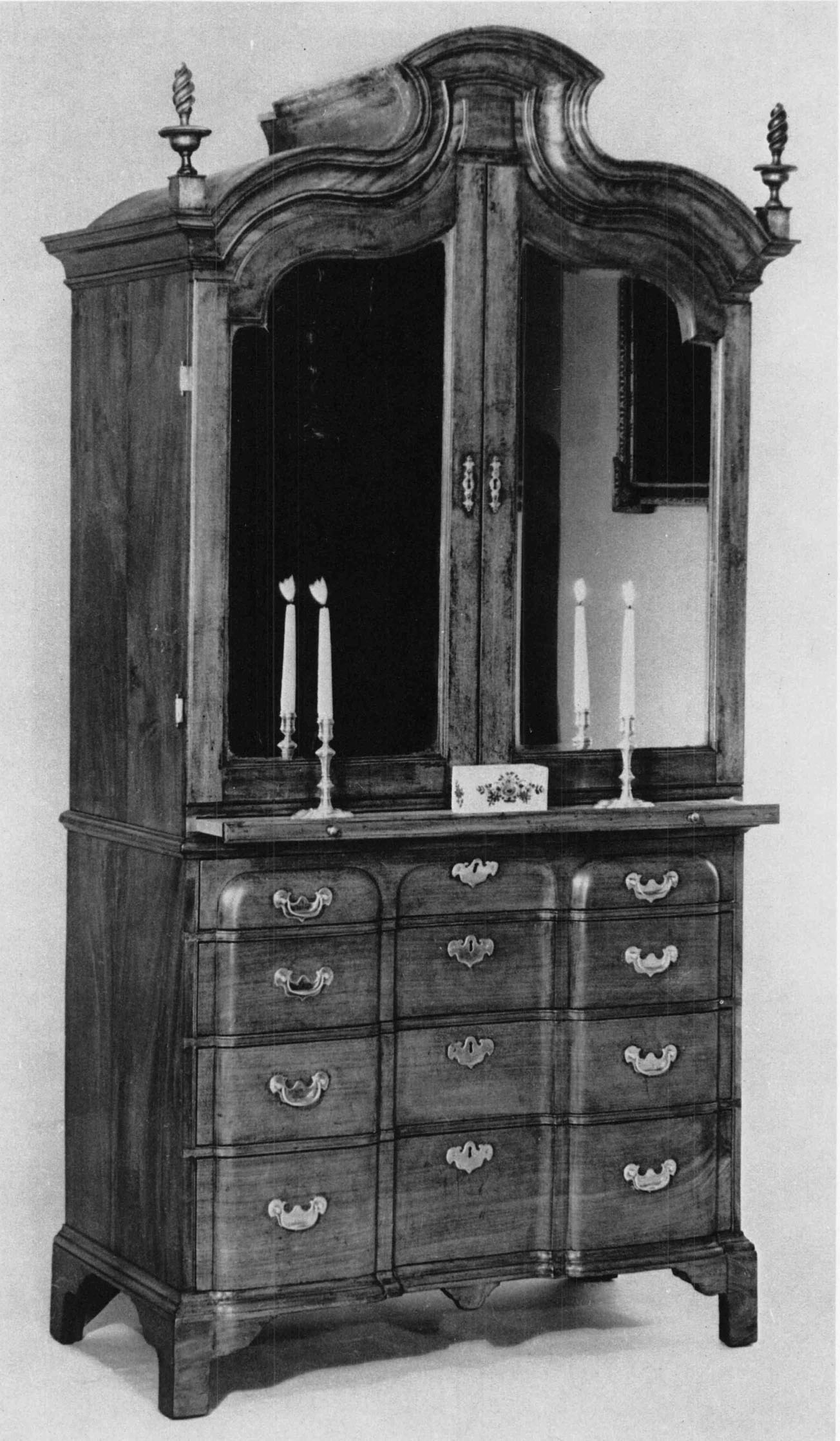
72. Chest-on-Chest. Boston area, c. 1730–1750. Mahogany and red cedar; h. 87 inches, w. 42½ inches, d. 21½ inches. (Ginsburg and Levy, Inc., New York City.) The sweeping bonnet and the doors in front of drawers in the upper section mark this group of chests as unusual and early.
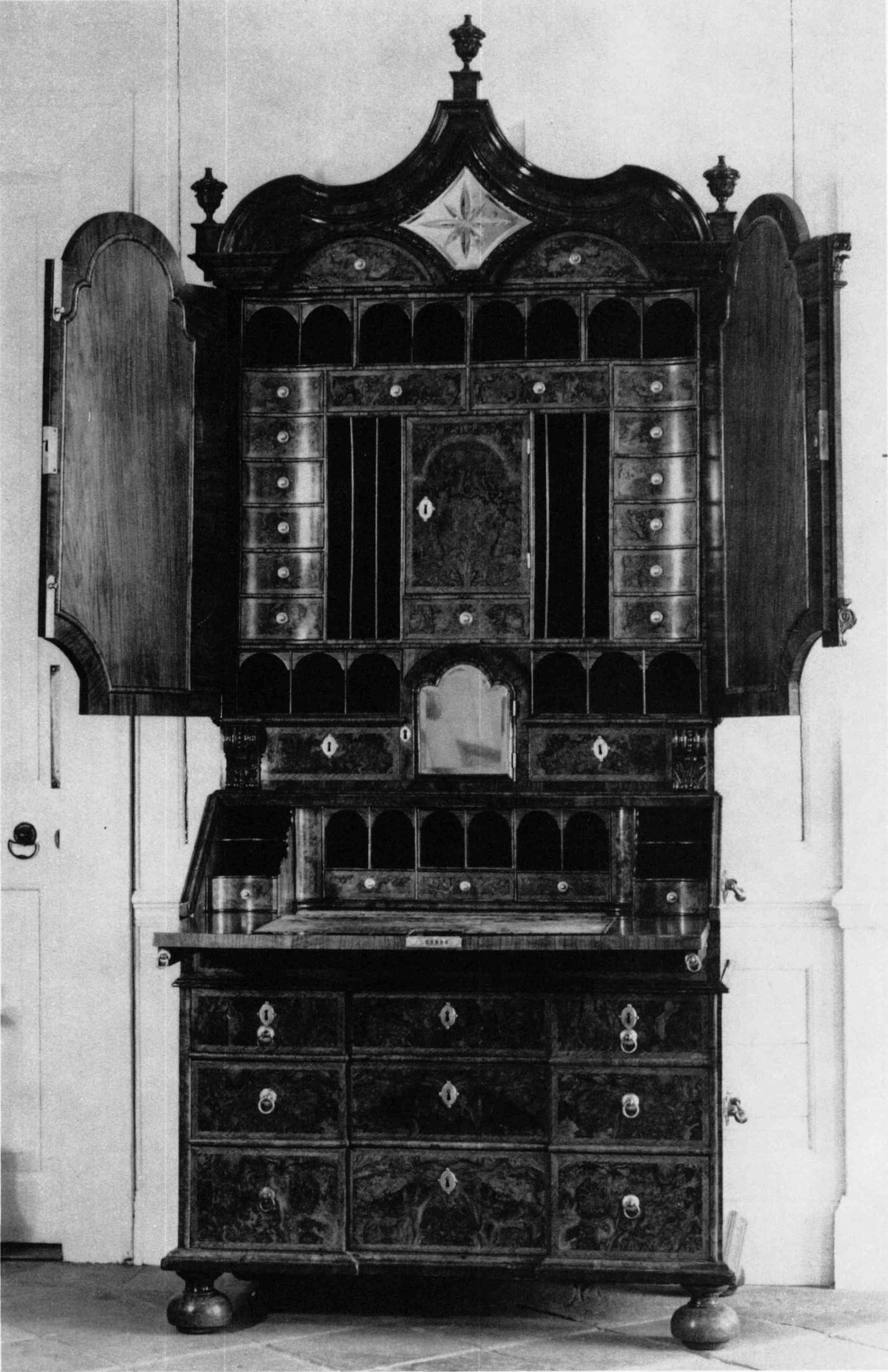
73. Desk and Bookcase. England, c. 1710. h. 104 inches, w. 42 inches, d. 25 inches. (City Art Gallery, Bristol, England.) This English desk with its curving pediment and recessed indentation in the lower section may be related to such American blockfronts as that illustrated in fig. 72.
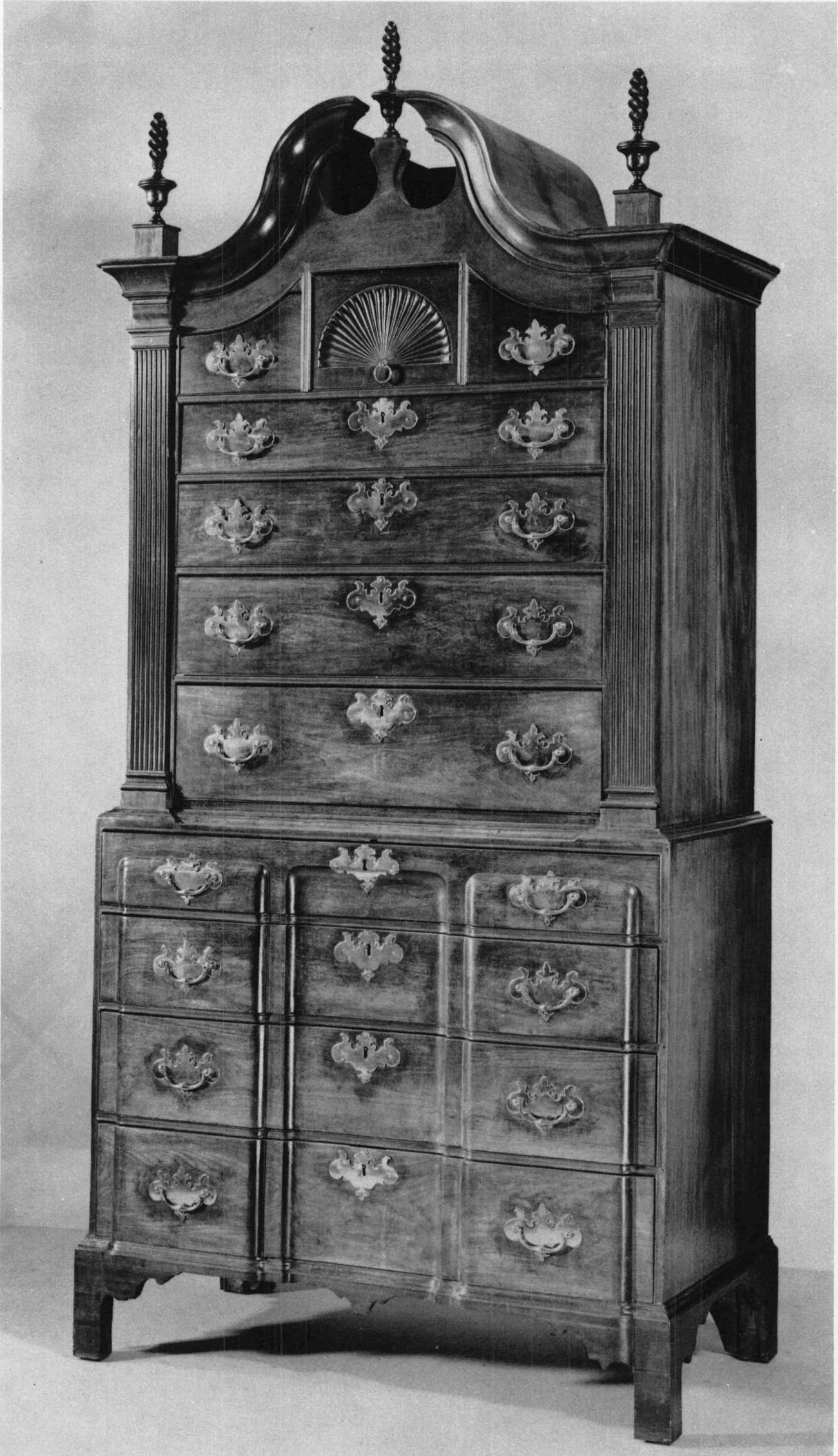
74. Chest-on-Chest. Attributed to Nathaniel Treadwell, Beverly, Massachusetts, c. 1780–1800. Mahogany and white pine; h. 92 inches, w. 42½ inches, d. 24 inches. (Yale University Art Gallery, Mabel Brady Garvan Collection.) See also fig. 75. This popular design was produced throughout the Boston area.
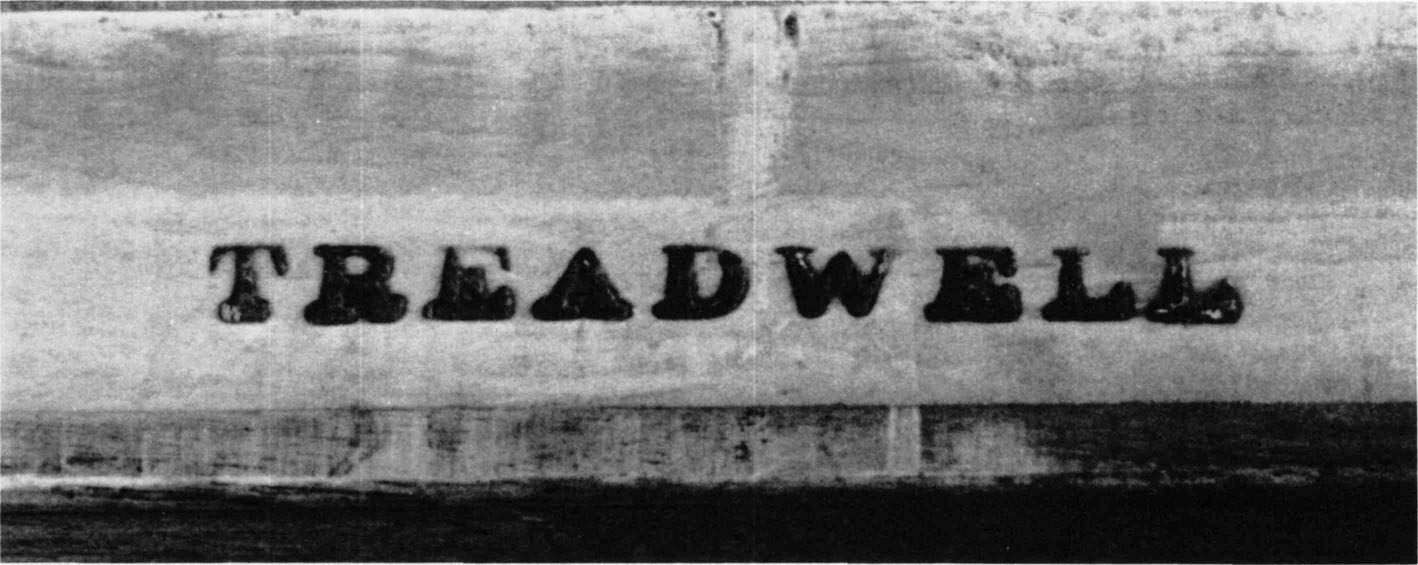
75. Detail of Treadwell Stamp on Chest-on-Chest. Attributed to Nathaniel Treadwell. (Yale University Art Gallery, Mabel Brady Garvan Collection.) See also fig. 74.
One might doubt the American origin of a chest with such a pediment, or the Boston provenance with cedar and oak substituted for the more habitual white pine secondary wood, but there is good evidence that this group of chests is indeed a Boston product. The construction is that of Boston, with the giant lower-frame dovetail and the run-through drawer dividers. And the design elements, including stiff bracket feet and central ornamental drop, are certainly Boston characteristics. Although two of the chests have lost their pre-twentieth-century history, the one at John S. Walton, Inc., New York, is said to have descended in the Green family of Boston.115
One might be led to suspect that the heavy baroque pediment with its rich curves is Continental in inspiration, perhaps Dutch. However, the closest parallel to this form is found in England. A desk at the Bristol City Art Gallery, said to be English, c. 1710, shows a rudimentary form of blocking in the bottom section and a rich undulating pediment above the doors (fig. 73). It is not unlike the three Boston “baroque” pedimented chests, although not an exact prototype.
In this unusual form may be seen a principle of Boston design which distinctly separates it from Newport work. The bottom section is blocked in a tripartite three-dimensional façade, while the top section is quite flat and linear (except in the capping elements), and follows a design pattern independent of the bottom section. This division between halves does not occur in Newport; there the design motifs echo and refer back to one another throughout the composition. In Boston there is a seemingly determined juxtaposition of linear with plastic elements, of top with bottom section.
There is another, later, distinctive group of chest-on-chests in which the blocked lower chest supports a flat-fronted series of drawers above (figs. 74–77). These upper drawers are flanked by fluted pilasters and are capped by three smaller drawers whose line echoes the curving pediment. Quite a few examples of this design survive; it seems to have been a popular solution to the problem of elegant storage. Although one might at first assume that this design type was characteristic of a single craftsman, examples do not derive from a single shop or even a single town. They represent the efforts of at least four cabinetmakers working north of Boston in such disparate areas as Charlestown, Marblehead, Salem, and Beverly. This fact is significant in view of the standard method of furniture attribution which tends to see similarities or identities of design as an indication of the work of one workman. This is a more appropriate procedure in rural areas where individual idiosyncrasies in detail, proportion, and design are fostered by isolation. But in the urban environment such similarities are no sure guide to a single source. A good businessman evidently kept his eye on his neighbor’s successful wares and adopted them when the public showed enthusiasm.116
One of the chest-on-chests of this type is in a private collection and bears the label of Benjamin Frothingham whose shop was in Charlestown (fig. 1).117 Frothingham descended from a prosperous family of chaise- and coachmakers. The products of his cabinetshop are well known today because quite a few pieces of furniture—tables, desks, high chests, both flat and blocked—bear his label. The practice of labelling furniture was not common in Boston. A label was apparently both a guarantee of quality and an advertising device, especially for furniture shipped as venture cargo. As his work is identifiable, Frothingham’s name is well known and anonymous products are often attributed to his workshop.
As close as the privately owned Frothingham chest-on-chest is to the similar example in the Garvan Collection (fig. 74), however, it is likely that the latter is the work of Nathaniel Treadwell of Beverly.118 It is stamped “TREADWELL” five times on the interior structural members (fig. 75).119 The Treadwell name is considerably more obscure in American cabinetmaking history than that of Frothingham. Treadwell’s interpretation of the typical Boston-area chest-on-chest appears somewhat narrower in the top section than the other two examples illustrated here: he has widened the pilasters and emphasized the upsweeping line of the cornice. It is, however, a well-proportioned interpretation of this familiar design.
Another little-known maker of a chest in this style is Abraham Watson of Salem (fig. 76).120 Although the chest-on-chest presently in a private collection in Salem is not signed by Watson, its history of descent in the Watson family and its fabrication for the cabinetmaker’s own use support this attribution.121 It deviates from the archetypal model of this form in small irregularities in the pediment area, but its overall design is the same.
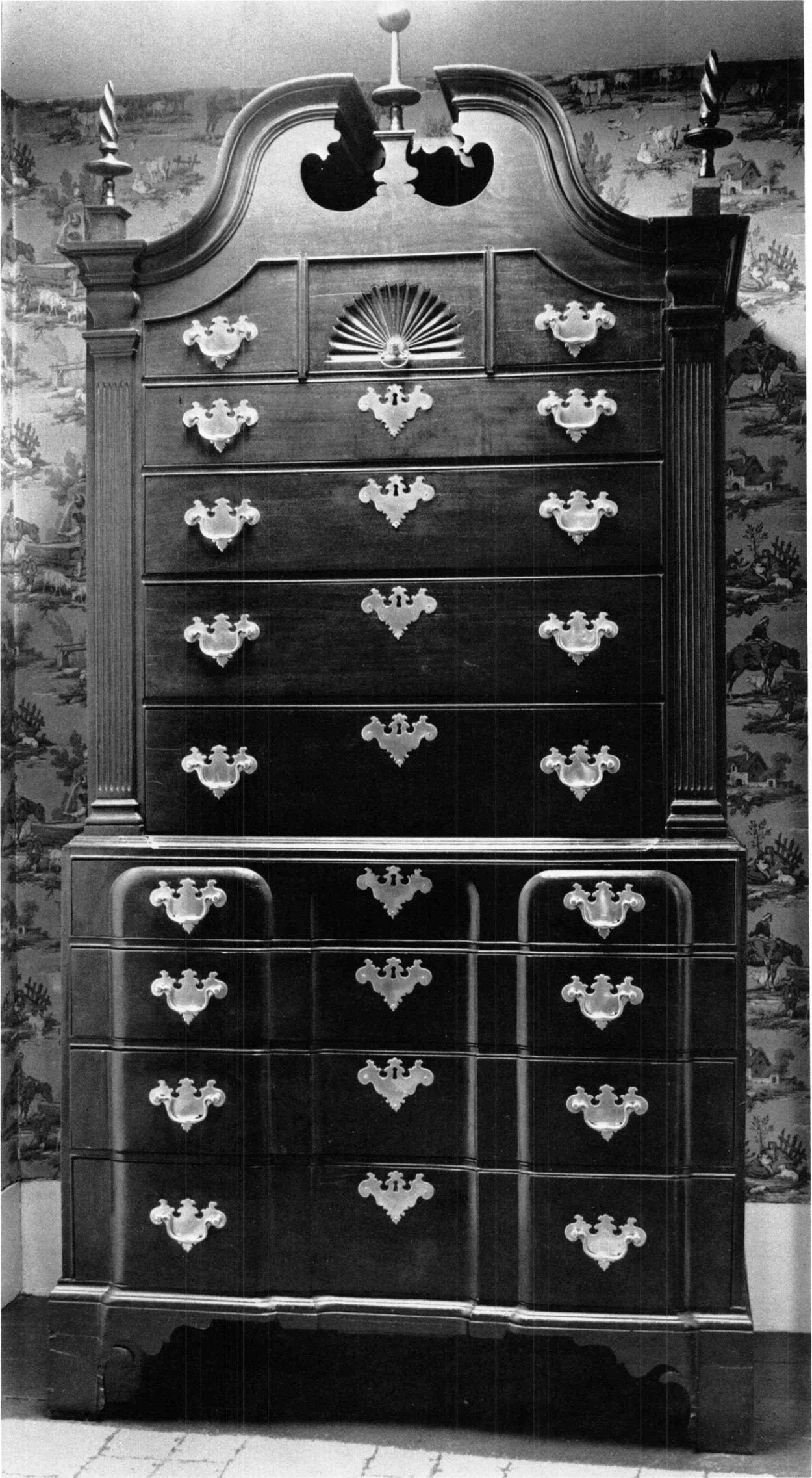
76. Chest-on-Chest. Attributed to Abraham Watson, Salem, c. 1770–1780. Mahogany and white pine; h. 84 inches, w. 42 inches, d. 15½ inches. (Private collection: photo, Samuel Chamberlain.) This chest descended in the family of Abraham Watson. One of two surviving pieces by this maker, the chest shows a classic formula with inventive detail.
One of the handsomest examples of this form is that in the Museum of Fine Arts, Boston (fig. 77). It is unsigned and may be the product of a cabinetmaker as yet unknown. However, its striking resemblance and nearly identical measurements in the upper chest to the doubly signed Ebenezer Martin and Nathan Bowen oxbow chest-on-chest (fig. 95) indicate that its source may well have been the Marblehead workshop of Bowen and Martin.122
The form of chest-on-chest seen in the previous four examples is particularly Boston in flavor. It combines a blocked lower chest with a flat-façaded upper chest of drawers yoked across the top by a beaded drawer outline and contained within pilasters. A stiffly carved fan and swan’s neck pediment complete the decoration of the upper case. Such a composition harmoniously unites diverse, almost antithetical elements. When the form first appeared is not known, but Watson is said to have made his chest for his new house in 1770. Frothingham worked until 1809, and Treadwell’s only known date is 1799. Thus the style spans the last quarter of the eighteenth century and probably intrudes into the nineteenth.123 This extreme conservatism—the clinging to a vital high-style aesthetic formula considerably beyond its ostensible period—is perhaps indicative of the gradual waning of Boston as a commercial giant and generative style center in favor of the newly wealthy towns of New York and Baltimore. However, the documentation of these four chests is most important as a testament of the multiplicity of producers and widespread popularity of a single form throughout the Boston area.124
Boston was a foremost mercantile city during the long era of blockfront popularity, so it is not surprising that some of the finest blockfront casepieces are desks. These richly grained mahogany sculpturesque desks often stand on bold claw and ball feet, and imply by their grand scale of design the worldly competence and solidity of Boston’s successful citizenry. This class of blockfront, the Boston slant-lid desk, was apparently made in large numbers and many survive. Most have been found in the vicinity of Boston, but it is evident that they were also shipped outside the immediate area. A walnut desk of this type on cyma bracket feet was located in Maine before the close of the eighteenth century—as the inscriptions by members of the Wasgatt family of Mount Desert attest.125 But both the histories and the makers of most of the Boston desks exemplified by figures 80 and 81 are obscure.
One prominent exception to the general anonymity of this form is a large, handsomely figured mahogany desk on hairy paw feet in the Historic Deerfield Collection (figs. 78, 168, and 169). It is labelled by the celebrated Benjamin Frothingham (fig. 79). Although the desk has been restored,126 it is essentially in its eighteenth-century guise and may serve as an introduction to the others of its type. All of these desks are very well made with neat, tight dovetails, boldly carved details, and precise stately proportions.127 In terms of design and elegance, these and the desks and bookcases form the grandest group of Boston blockfronts.
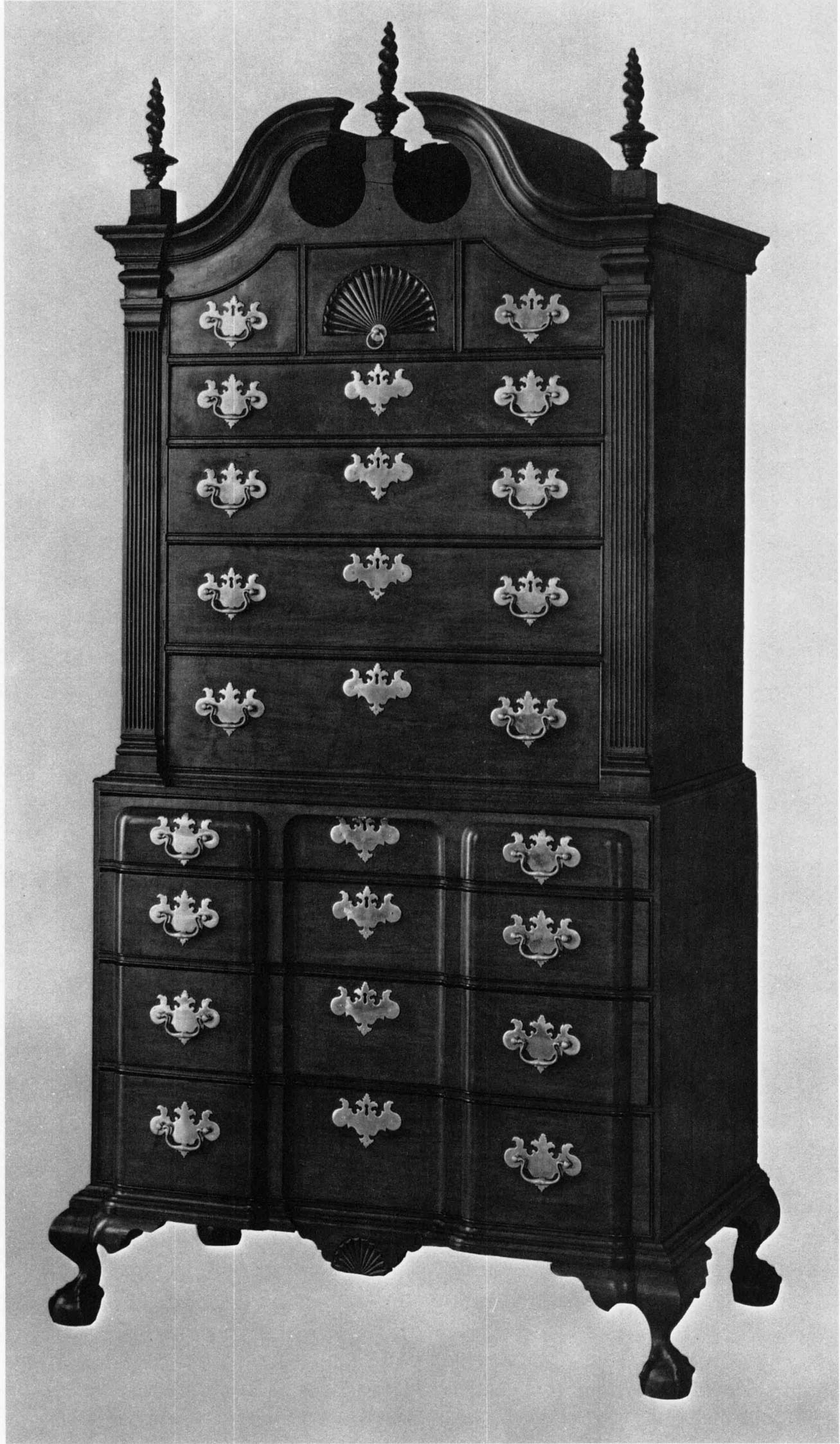
77. Chest-on-Chest. Marblehead, Massachusetts, area, c. 1760–1790. Mahogany and white pine; h. 91½ inches, w. 41½ inches, d. 24⅞ inches. (Museum of Fine Arts, Boston, Bequest of Mrs. Sarah W. Whitman, 04.1727.) The visual discontinuity between the upper and lower sections of this chest is typical of Boston-area design.
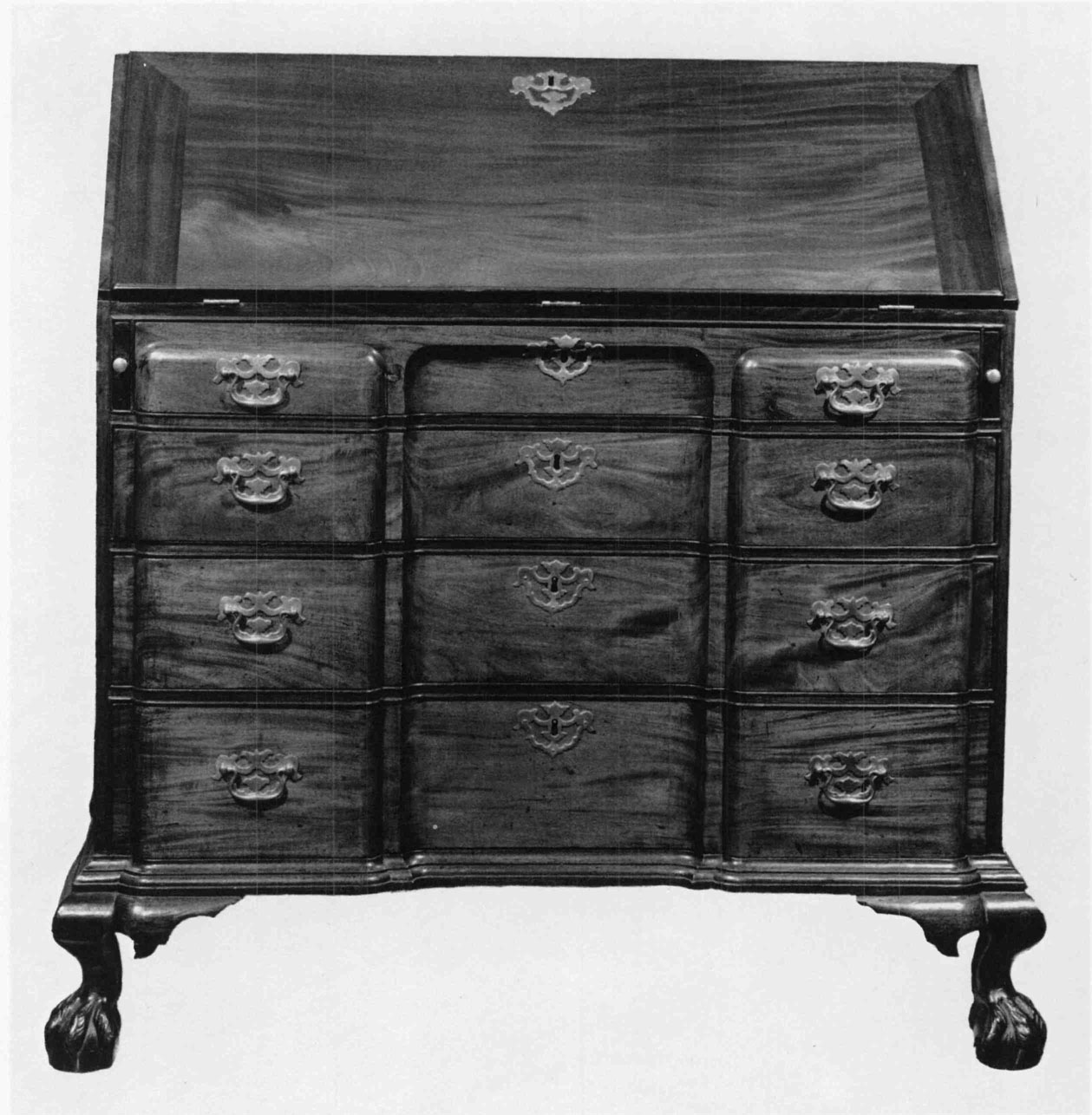
78. Desk. Made by Benjamin Frothingham (paper label), Charlestown, c. 1755–1790. Mahogany and white pine; h. 49½ inches, w. 45½ inches, d. 25½ inches. (Historic Deerfield, Inc., Deerfield, Massachusetts.) See also figs. 79, 168, and 169. One of the most successful of Boston-area blockfront designs, this example stands on elegant hairy paw feet.
A desk in the Garvan Collection of this type (fig. 80), traditionally said to have descended in the Winthrop family of Boston, is very much like the Deerfield desk. It differs principally in the arrangement of the interior. The Garvan desk exhibits the classic formula for Boston blockfront interiors: the bottom tier is flat, plain-fronted, and on an advanced plane. The central fan-carved door is flanked by unfluted colonnettes, paired pigeonholes above notched single drawers, and finally by fan-capped pairs of shallowly blocked drawers.128 This formula changed, however, as the century progressed. By the 1760s Newport was making extremely fine furniture and one finds, curiously enough, in such an example as the Boston desk illustrated in figure 81 an echo of the standard Newport formula for desk interiors (fig. 82). Still evincing the Boston preference for the advanced lower tier and the stiffly carved fans, the example illustrated in figure 81 adopts the Newport concave arched drawers above the pigeonholes. That the influence is that of Newport on Boston is more definitely established by a handsome but hybrid Massachusetts desk and bookcase at the Museum of Fine Arts, Boston (fig. 83). Its interior is wholly after the pattern of Newport except in the retention of the colonnettes on the document drawers. The adoption of the Newport style, however, is strictly confined to this interior section—the general construction of this desk and bookcase and its decorative details are distinctly Boston.
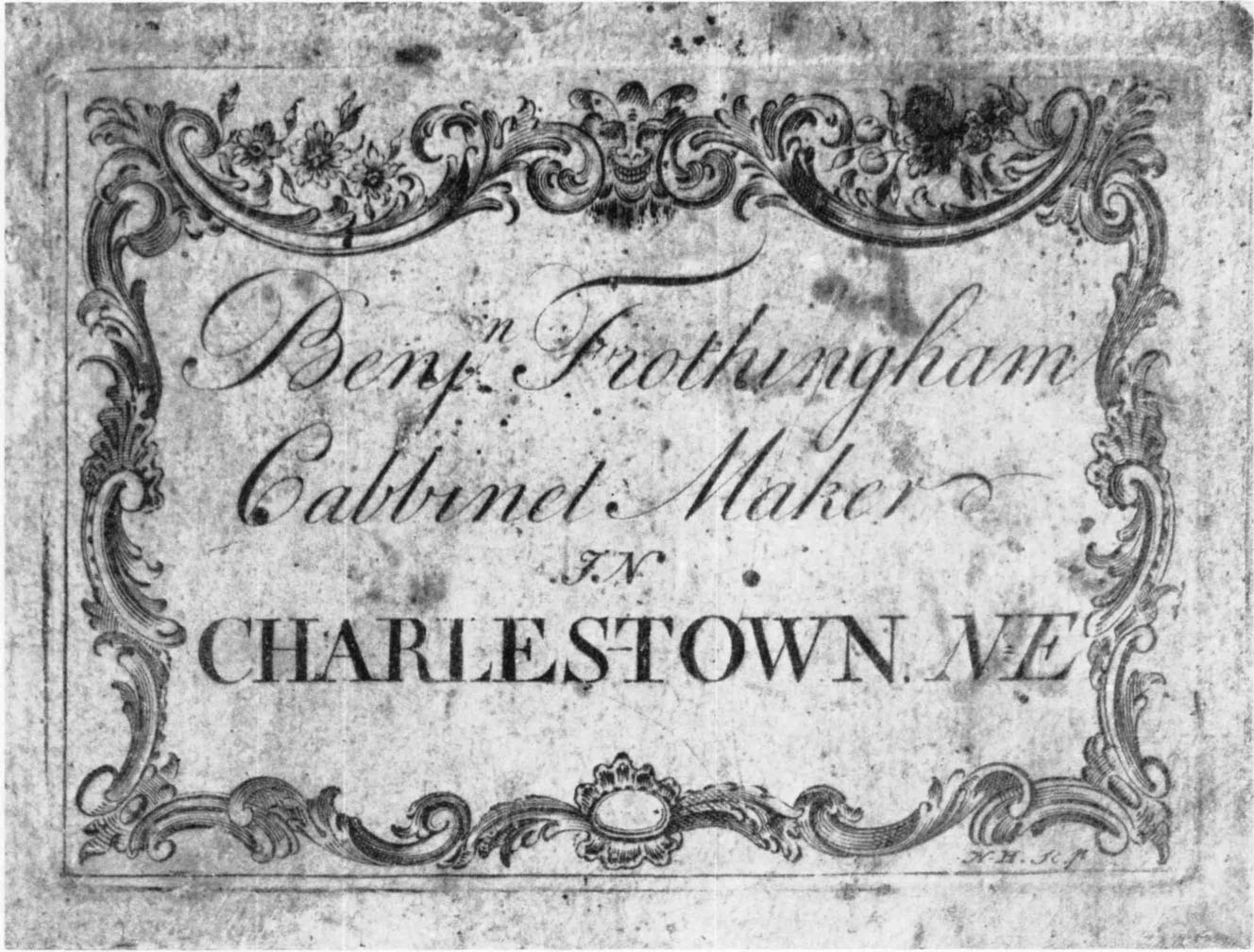
79. Detail of Paper Label on Desk: “Benjn. Frothingham / Cabbinet Maker / IN / CHARLESTOWN. NE.” (Historic Deerfield, Inc., Deerfield, Massachusetts.) See also figs. 78, 168, and 169.
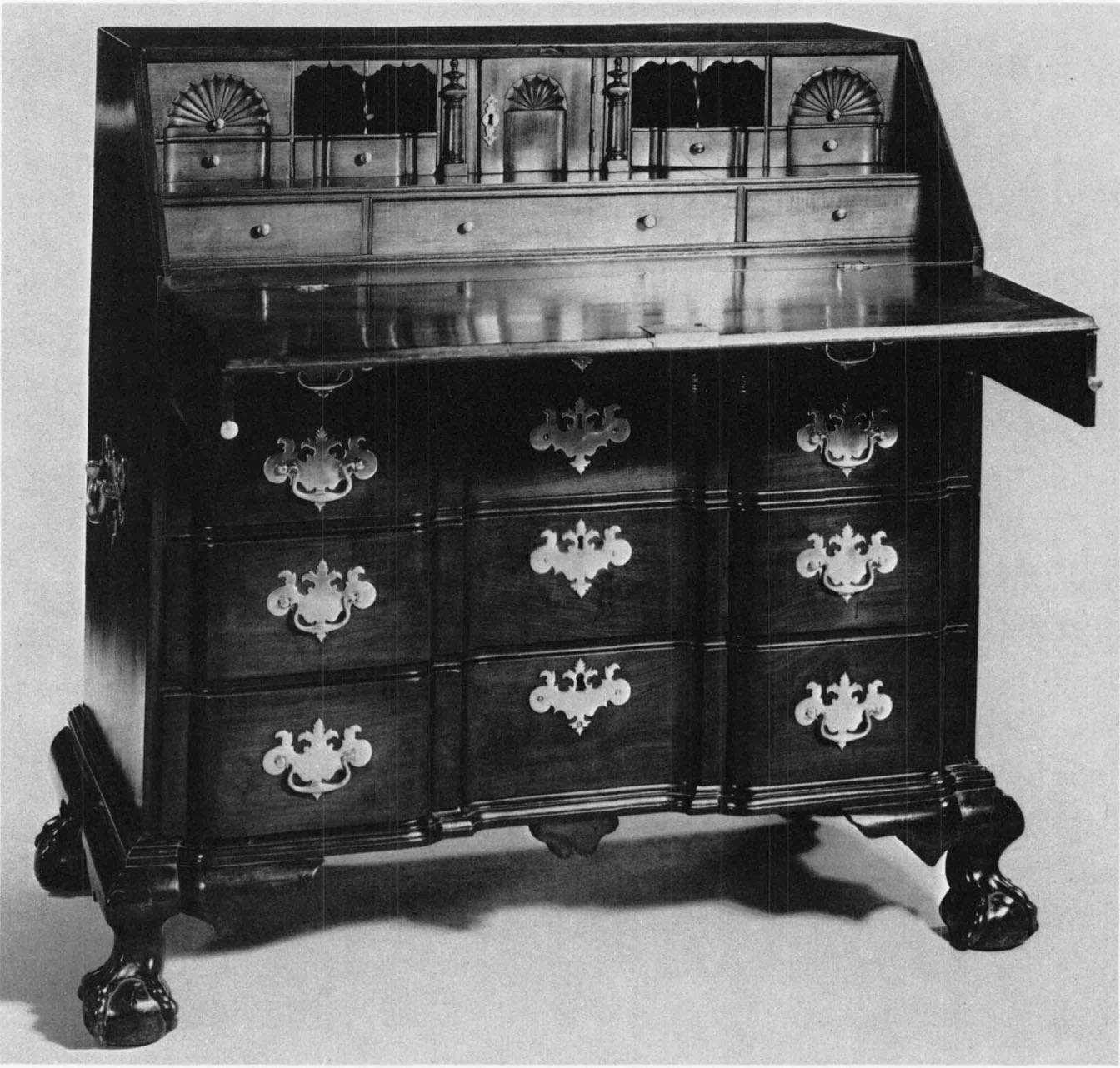
80. Desk. Boston area, c. 1750–1770. Mahogany and white pine; h. 44½ inches, w. 46½ inches, d. 23½ inches. (Yale University Art Gallery, Mabel Brady Garvan Collection.) This two-tiered desk interior was much favored in Boston.
The autonomy of regional styles was based upon isolation of one style center from another, and other more complex factors. The preferences of patrons, the apprentice system, and the independent specialist suppliers were major factors in the codification of a style, and may have done much to produce the local unity of a “school.” But intercity trade and communication in eighteenth-century New England was lively and the craftsmen in Newport and Boston were certainly aware of each other’s products.
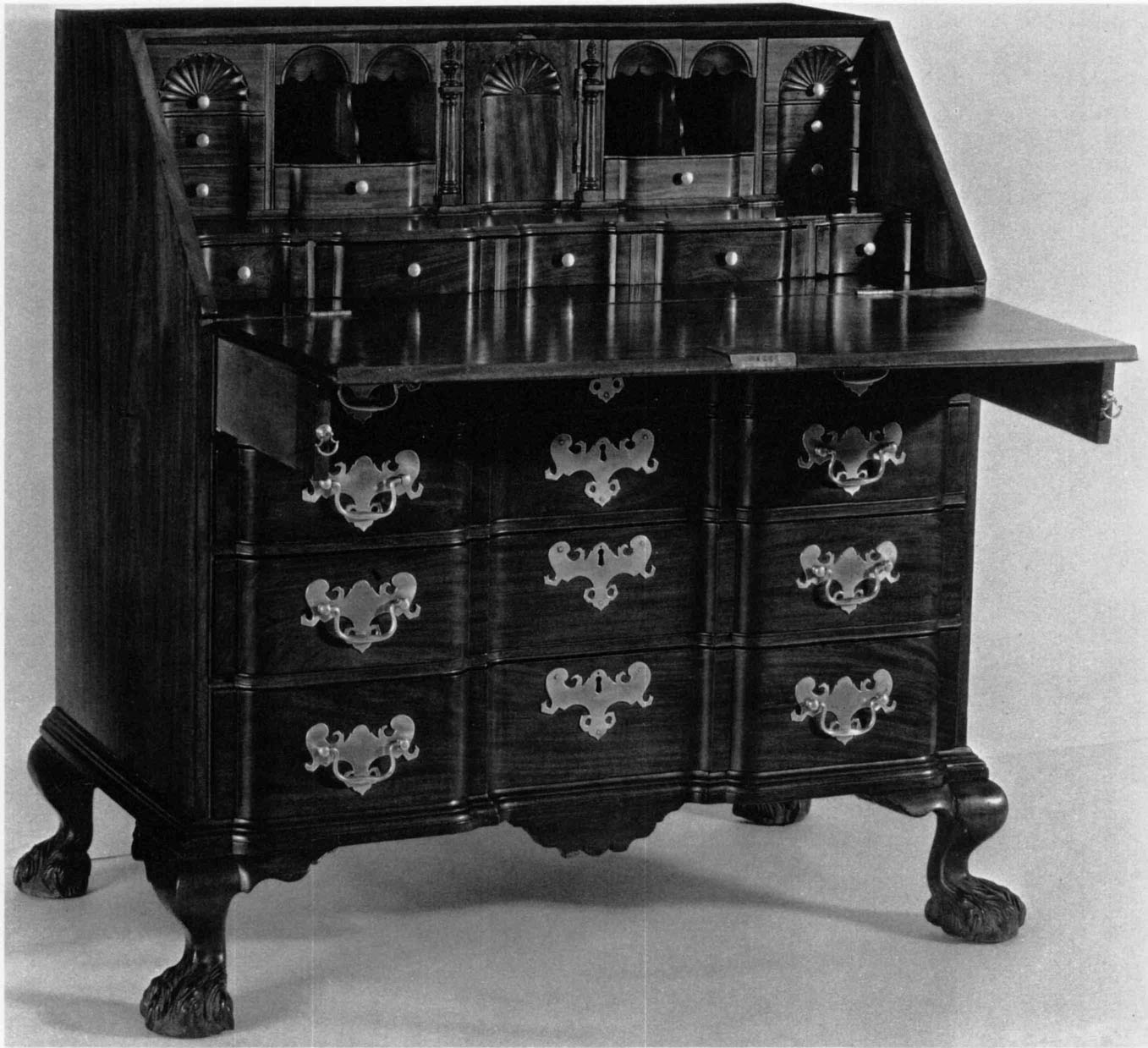
81. Desk. Boston area, c. 1760–1780. Mahogany and white pine; h. 44¾ inches, w. 41 inches, d. 22⅜ inches. (Museum of Fine Arts, Boston, M. and M. Karolik Collection, 39.87.) The influence of Newport is evident in the cusped pencil drawers.
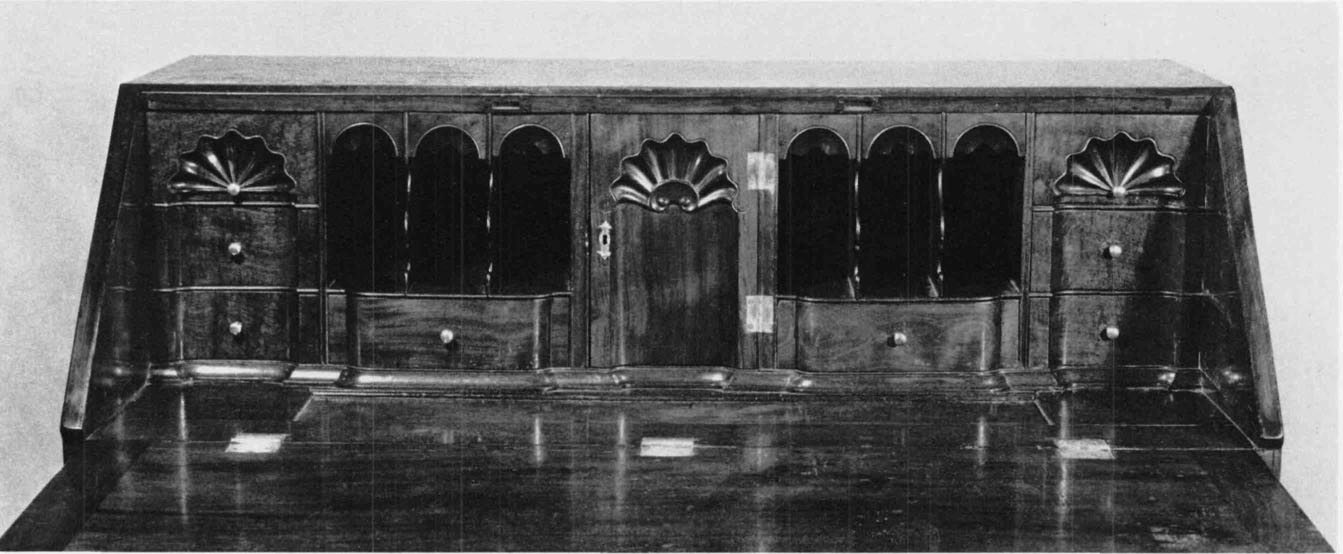
82. Interior of Desk. Made by John Townsend, Newport, 1765. Mahogany, cedar, and tulipwood; h. 42 inches, w. 42 inches, d. 23 inches. (Israel Sack, Inc., New York City.) For an overall view of the desk, see Antiques, ci (January, 1972), inside cover. The archetypal Newport desk interior in a signed and dated example.
The movement of craftsmen from Boston to Newport may be documented from early in the century.129 But perhaps more important for the migration of furniture styles were the close commercial ties between merchants in both cities.130 Stephen Greenleaf, a wealthy merchant of Boston, supplied his friends in Newport with furnishings and paintings commissioned in Boston. In a letter of May 26, 1749, to Abraham Redwood, in Newport, Greenleaf records: “I receiv’d yours p[er] Friend Proud and have ordered the Chairs and two roundabouts to be made which will be strong and neet and not high pris’d—have searched ye town for a [Looking] Glass and can have some of ye Size you want @ £75, but there is some Guilding about them which you wont like; I design to get one made for you that will be plain & hope will please—& shall have it ready in a fortnight, and possibly ye chairs may be done to go with it.”131 Such Massachusetts-made furnishings sent to Rhode Island might well have included blockfront casepieces which were seen, imitated, and adapted by local craftsmen.
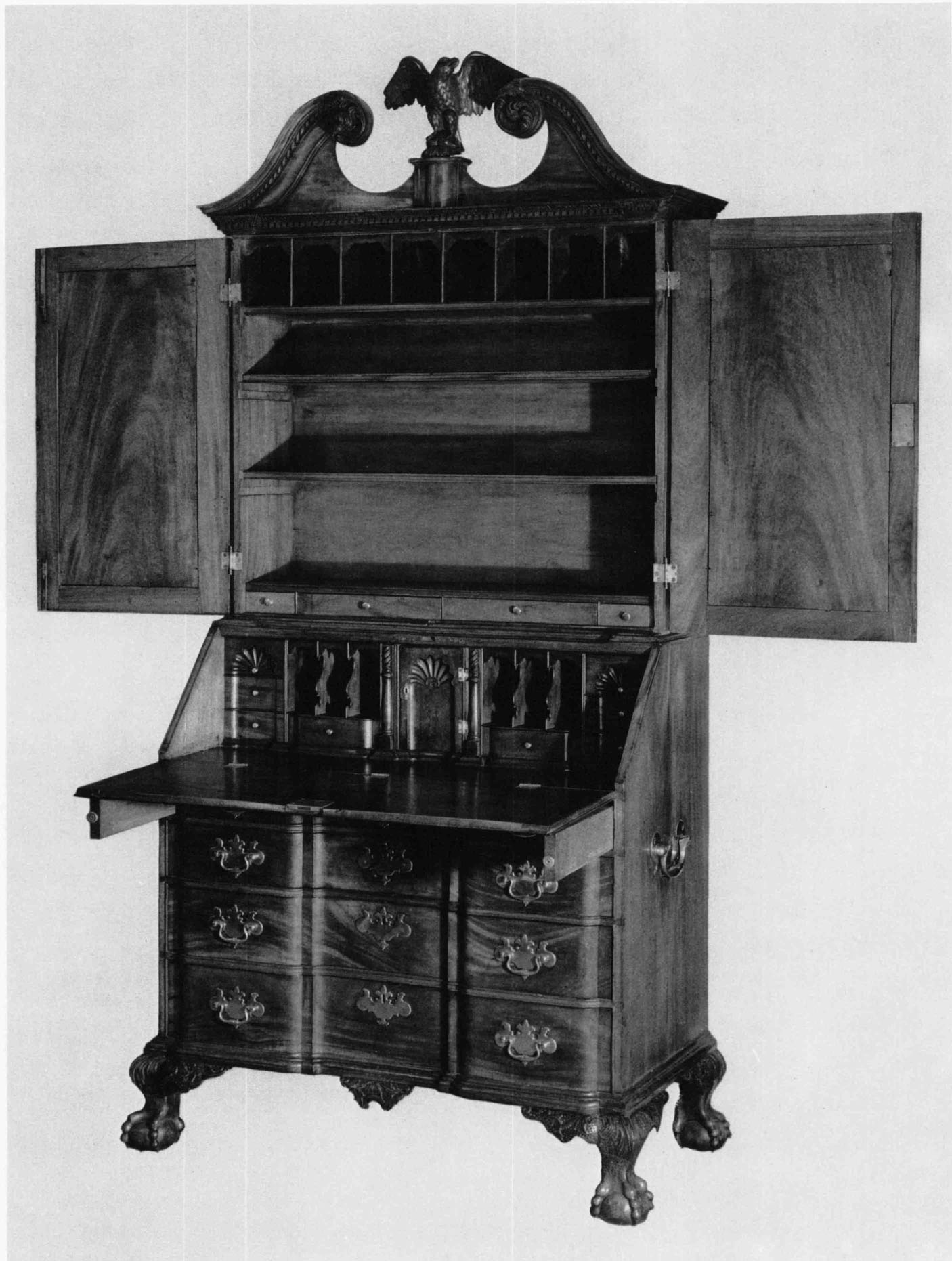
83. Desk and Bookcase. Boston area, c. 1770–1800. Mahogany, chestnut, white pine, and tulipwood; h. 95⅝ inches, w. 42⅜ inches, d. 22 inches. (Museum of Fine Arts, Boston, M. and M. Karolik Collection, 39.156.) According to family tradition, this desk and bookcase descended in the Cooke family of Rhode Island. The influence of Newport is pronounced in the desk interior, but the exterior appearance, case construction, and interior colonnettes are typical of Boston.
The adoption of the blockfront façade by Newport craftsmen around the middle of the century is more easily understood than the apparent countercurrent of influence which occurs a decade or two later. The use of Newport-type desk interiors in Boston has been discussed above. By far the most significant influence on Boston-area blockfronts by Newport is seen in the products of Salem. In that area, Newport construction techniques as well as design principles fuse with the native product to produce a wholly distinctive style. The use of a blocked desk lid, of squared (rather than slightly rounded) corners on the blocking of the top drawer and the use of the flat mahogany strip instead of the giant Boston dovetail at the bottom of the case are Newport elements found in Salem blockfronts of the 1770 to 1790 period.
The source of the Newport influence in Salem work is not clear, but it may be a result of the close connections maintained among Quakers in eighteenth-century New England. Ezra Stiles, a curious and faithful observer of civil and religious matters, records: “Quakers In New England are resolved into 3 Quarterly Meetings of Business & One Yearly Meeting of Business. The three Quarterly Meetings are Salem, Sandwich, and Newport. . . . Delegates or messangers from the two Quarterly Meetings of Salem and Sandwich assemble at the Yearly Meeting of Business in Newport. . . . The whole state of the Quaker Interest in New England is from year to year transmitted by the yearly meeting from Newport to the General Meeting in London.”132 The Townsend family—well-known makers of the Newport blockfronts—were staunch Quakers as were other lesser-known Newport craftsmen. Perhaps the Yearly Meetings facilitated friendships and exchanges which introduced Newport design and construction techniques into Salem work.
Whatever their source, the Salem blockfront desks are distinctive. The only signed example was made by Henry Rust, a little-known cabinetmaker who worked in Salem, c. 1762 to 1800 (figs. 84 and 85).133 The Rust desk stands on dwarf cabriole legs with claw and ball feet and undulating brackets of a type well known in the Boston area. The use of a central drop is also a Boston-area characteristic, but here ornamented with an unusually three-dimensional, realistic scallop shell. This three-dimensional shell is a recurring motif in the desks of this group. The blocked desk lid is also peculiar to this group—echoing the use of the blocked lids in Newport work and here producing the same effect—a unified façade, the parts of which refer to and echo one another. However, in the examples of this type which include a bookcase the Boston custom of a clear delineation between the decorative pattern of the top and bottom halves prevails.
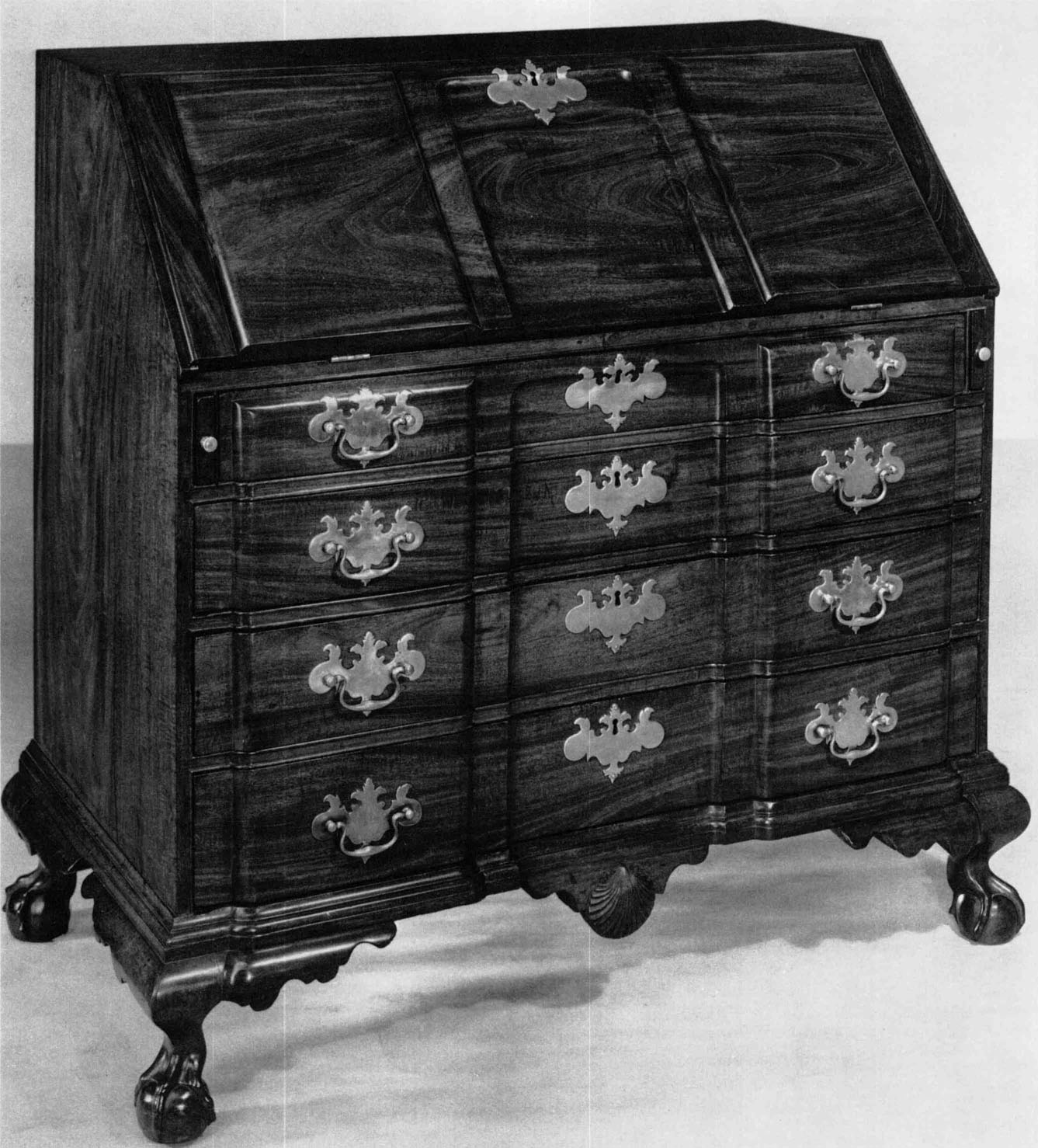
84. Desk. Made by Henry Rust, Salem, c. 1762–1800. Mahogany and white pine; h. 44 inches, w. 41½ inches, d. 22 inches. (Ginsburg and Levy, Inc., New York City.) See also fig. 85. Features of this desk—square-cornered blocking, realistic ornamental scallop shell, blocked desk lid, and Newport-type case construction—are distinctive of Salem.
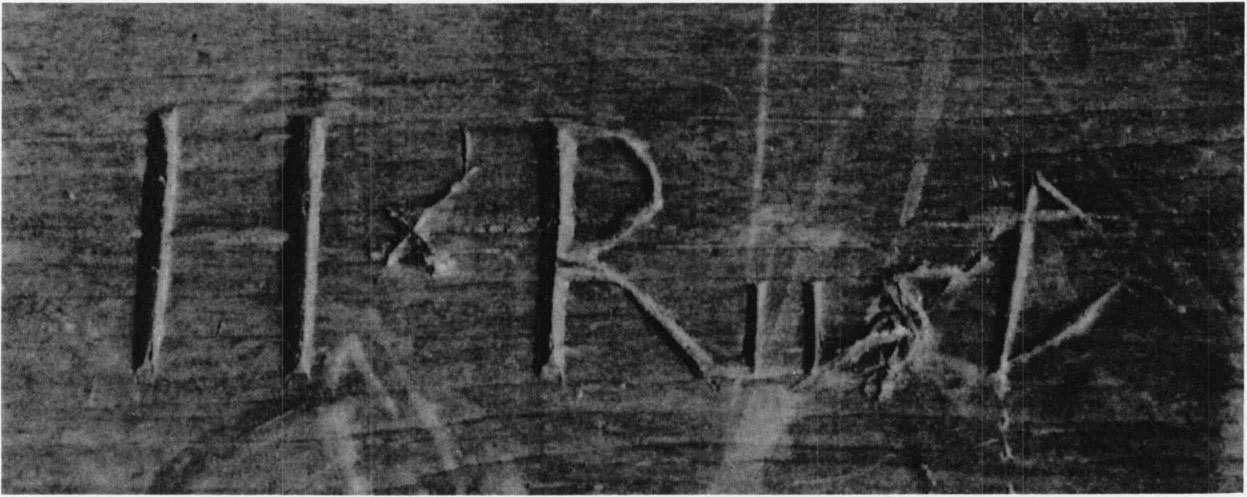
85. Detail of Carved Inscription on Bottom of Desk: “H x Rust.” (Ginsburg and Levy, Inc., New York City.) See also fig. 84.
A related monumental desk and bookcase was purchased by Joseph Waters of Salem about 1780 and descended in the Waters family. It is an archetypal example of this Salem form (fig. 86),134 incorporating the blocked desk lid, three-dimensional scallop shell, and Newport case construction seen in the Rust desk. A similar desk and bookcase with Skillin-family carved allegorical figures on the pediment is in the Metropolitan Museum of Art (fig. 87). Another example of this type is in the Garvan Collection at Yale (fig. 88),135 and a fourth is owned by Ginsburg and Levy, Inc., New York (fig. 89). With slight differences these desks all conform to the same general design and construction principles, and were probably all made in the Salem area. Their significance lies not only in their handsomely rational design but also in their testament to the communication and exchange of ideas between Newport and Boston-area cabinetmakers.
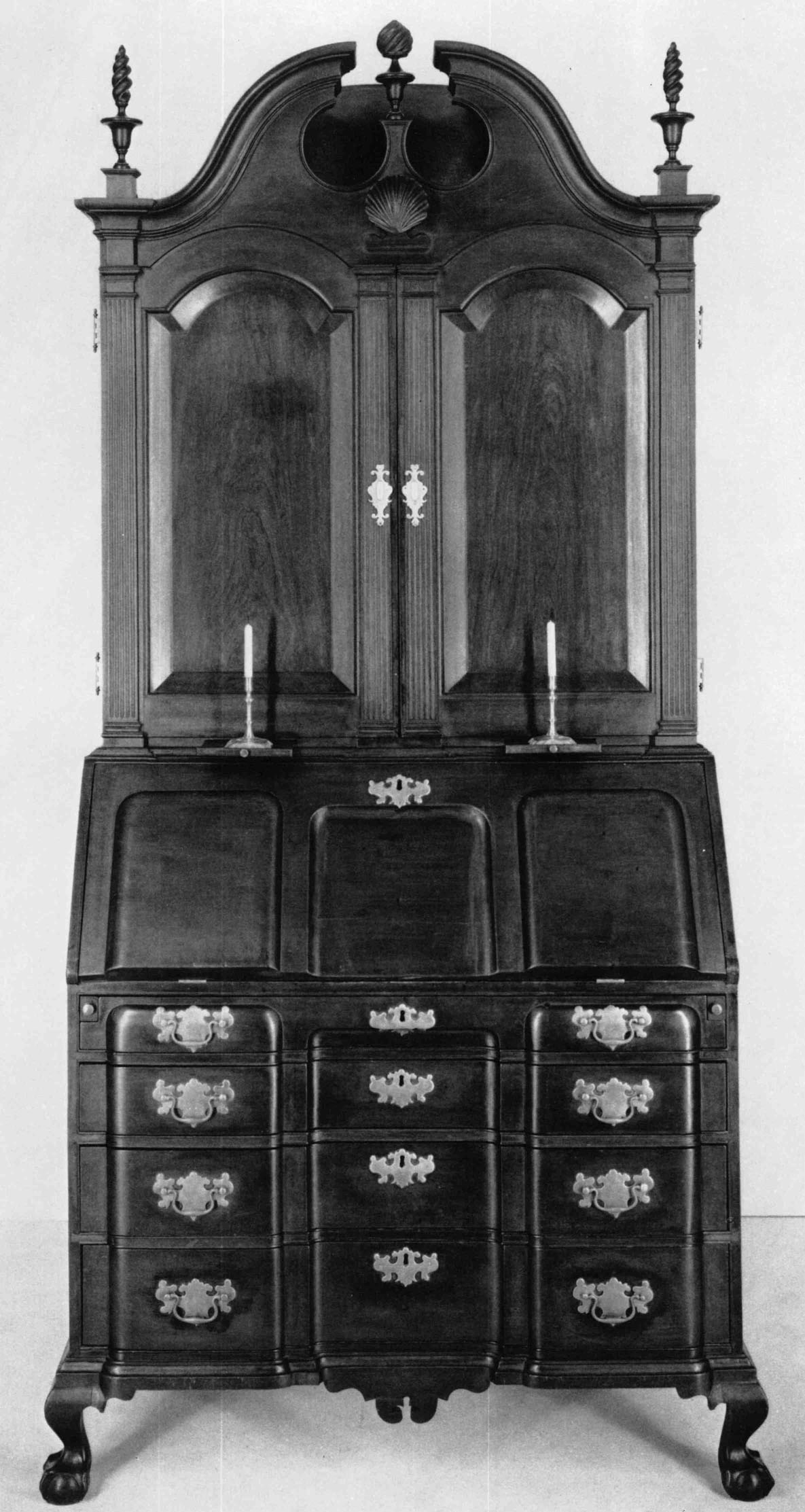
86. Desk and Bookcase. Salem, c. 1770–1790. Mahogany, white pine, and white oak; h. 90 inches, w. 41 inches, d. 23 inches. (The Henry Francis du Pont Winterthur Museum.) Bought by Joseph Waters (1756–1833) of Salem, this desk and bookcase descended in his family.
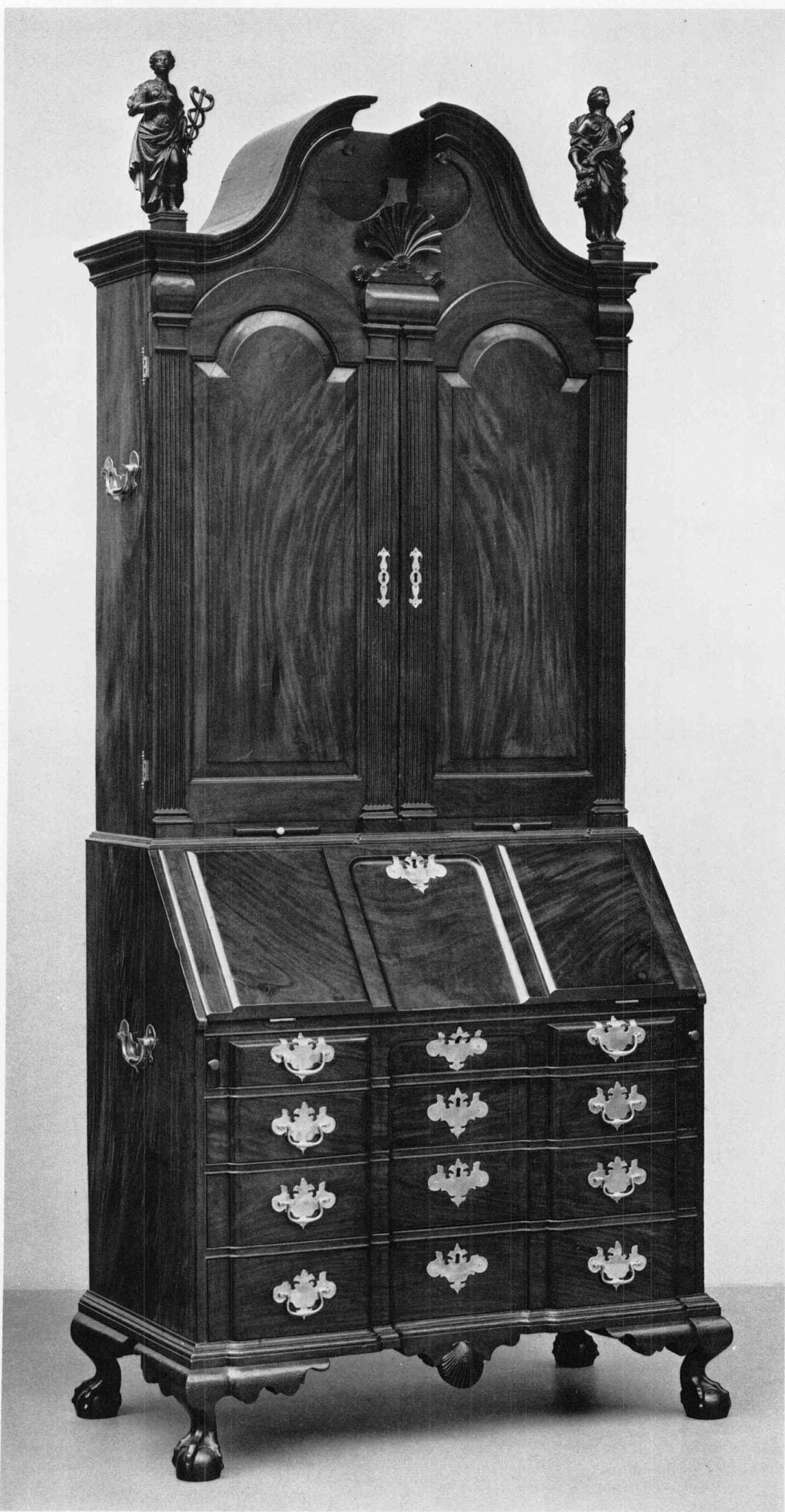
87. Desk and Bookcase. Salem area, c. 1770–1800. Mahogany and white pine; h. 101 inches, w. 42 inches, d. 23 inches. (The Metropolitan Museum of Art, Gift of Mrs. Russell Sage, 1909.) The figures on this desk and bookcase were carved by the Skillin family.
The movement of design ideas between communities was not confined to the stylish urban centers and the prosperous North Shore communities. Joseph Hosmer of Concord (1736–1821), although trained by an immigrant Frenchman (Robert Rosier), appropriated the Boston styles.136 He was, according to contemporary accounts, “a farmer and a cabinetmaker,” a yoking of vocations not unusual in rural communities.137 When called upon to make a distinguished piece of furniture for the new house (built in 1769 and now known as “the Old Manse”) of Concord’s eminent clergyman William Emerson, Hosmer employed fashionable blocking to update and refine an old form—the high chest (fig. 90). Blockfront high chests are rare—perhaps because of the fundamental visual disharmony of “animal” legs supporting an architectonic shape. It is significant that the blockfront motif was so well known and widely understood as an index of status that it is borrowed and misapplied even when it contradicts the integrity of the basic form.
In another sense, the importance of this blockfront is considerable because it is the only instance in which the maker (and the maker’s teacher), the date of manufacture, the patron, and the house for which a blockfront was made are all known. Although there are no inscriptions on the highboy itself, the static nature of Concord reinforces the probable accuracy of this tradition of fabrication, ownership, and residence.138 The imposing height of the high chest and the use of high-style decorative motifs imply a social statement consistent with the status of an important clergyman. The blocked façade is a nod toward the refinement and elegance of contemporary urban establishments of distinction.
Perhaps the masterpiece of the Boston blockfront tradition is the handsomely proportioned and exquisitely detailed desk and bookcase illustrated in figure 91. The patron who commissioned this work was Colonel Josiah Quincy (1710–1784), an extremely wealthy gentleman. He had retired from commerce in 1748 when a single venture of his ship Bethell, a privateer, netted him one hundred sixty-one chests of Spanish silver and two chests of gold.139 The desk is inscribed: “This desk was / purchased by /Josiah Quincy / Braintree 1778.” In 1770 Colonel Quincy had rebuilt his house in the latest taste. “At that time,” records Eliza Susan Quincy in the mid-nineteenth century, speaking of the 1770s, “it was considered as a spacious and elegant mansion.”140 The house still stands in Quincy, overlooking the harbor. The purchase of this desk may have been necessitated by the loss of furniture in the fire of 1769 which destroyed the original house. However, it is probable that it was inspired by a wish to acquire elegant furnishings worthy of the fashionable new interior, as several considerably older pieces of furniture evidently survived the fire.141
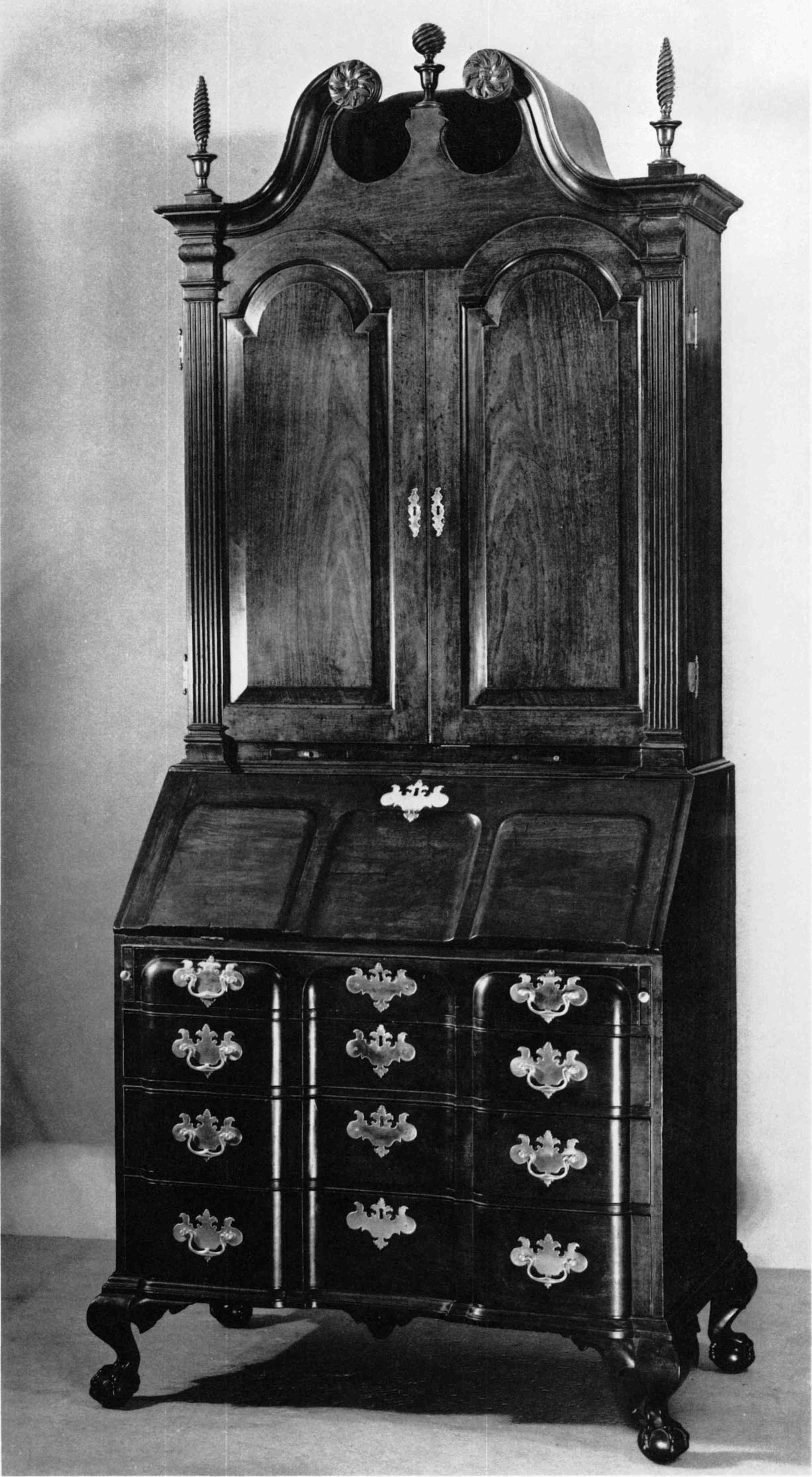
88. Desk and Bookcase. Salem area, c. 1770–1800. Mahogany and white pine; h. 100 inches, w. 43¼ inches, d. 24¾ inches. (Yale University Art Gallery, Mabel Brady Garvan Collection.)
According to the inventory taken at Colonel Quincy’s death in 1784, a desk and bookcase, valued at a considerable £7:4:0 (the only desk and bookcase in the house), was located in the east lower room. This room was evidently the best parlor for there are found also “1 Marble Slab Mohogany Frame [pier table] 96 [shillings]” and such accoutrements of the elegant life as a “Glass Pyramid,” a hamper of Queensware, and “12 Fruit Knives & 12 Forks Silver handled.” Such a place was suitable to the proper rococo dignity of the Quincy blockfront. But unfortunately it was made toward the end of the Chippendale style period, and the thin tight rectilinear Federal style soon eclipsed its artistic virtues and status value. According to Eliza Susan Quincy, a “carved desk and bookcase”—almost certainly this one—was “bought by a farmer in the neighborhood [but] was bought back in 1840 and is now in the possession of the family.”142
The maker of this blockfront is unfortunately unknown. Its details of construction and design are unusual in some respects (for instance, the thinness of the drawer sides), but consistent with Boston-area practice. The secondary wood is red cedar in the larger drawers, and mahogany in the desk interior. Perhaps the most striking aspect of this monumental desk is its carved details.143 Elegantly conceived and executed, they tie the composition together and emphasize its plastic architectural quality.
Colonel Quincy was a man of richly refined taste and a patron of the arts. His portrait by John Singleton Copley, painted in 1769, portrays a man of elegant solidarity, his dress highlighted by light rococo details (fig. 92). In similar fashion the solid, formal Queen Anne structure of the desk and bookcase is punctuated by airy, even whimsical touches in the carving. The American interpretation of the rococo mode in all the arts followed this pattern of fashionable, delicately rococo touches on an unmistakably solid structure. In this sense the Quincy desk and bookcase is as much a monument of its country and period as the great Philadelphia high chests. It is an artistic fabrication composed of diverse elements which are transformed and integrated into a successful whole. It represents the summit of Boston blockfront design and equals the celebrated block-fronts of Newport.
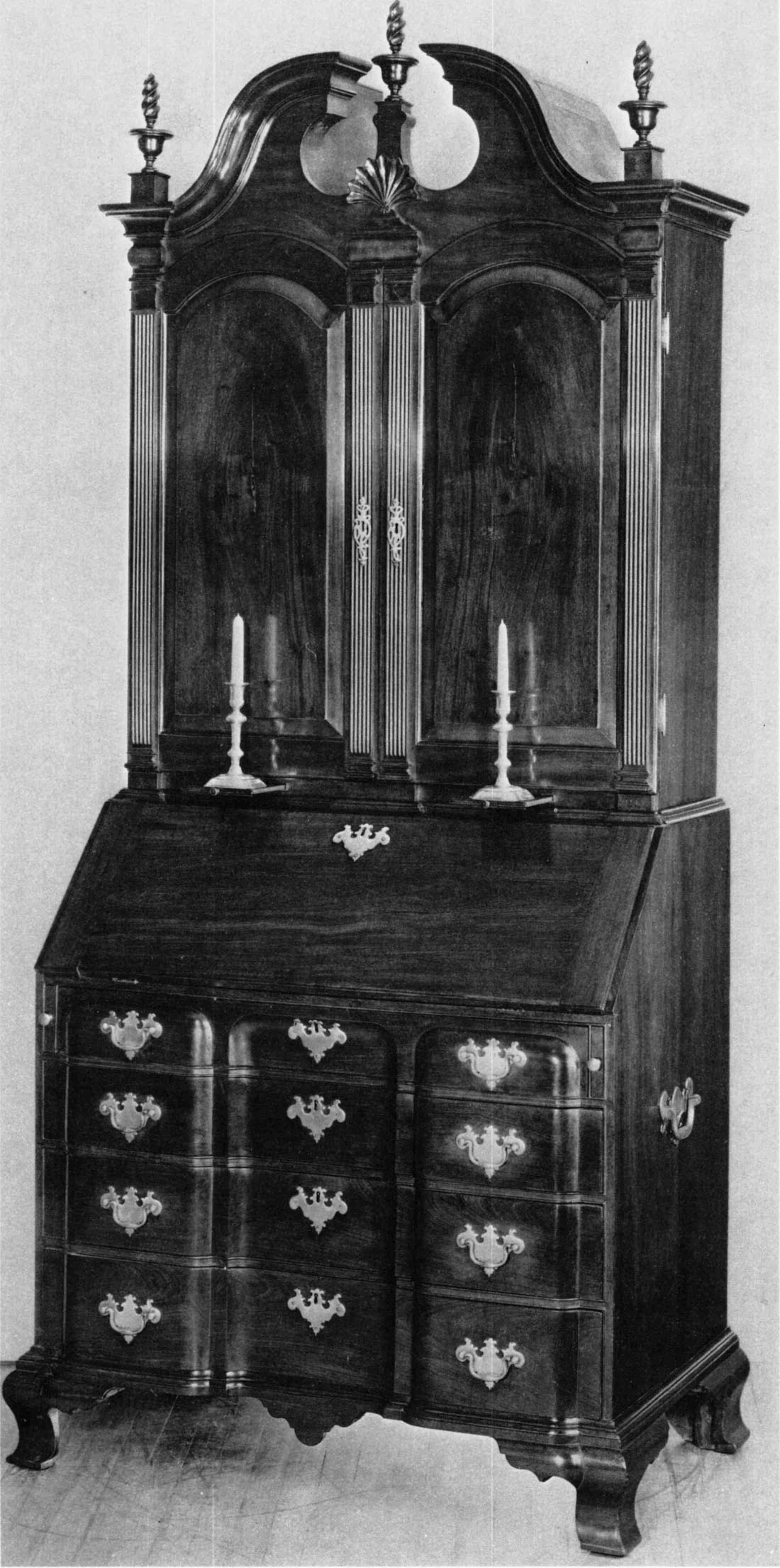
89. Desk and Bookcase. Salem area, c. 1770–1800. Mahogany and white pine. h. 100 inches, w. 42 inches, d. 23 inches. (Ginsburg and Levy, Inc., New York City.) Combined with other elements familiar to this group of desks (see fig. 84) are feet reminiscent of the classic Newport type.
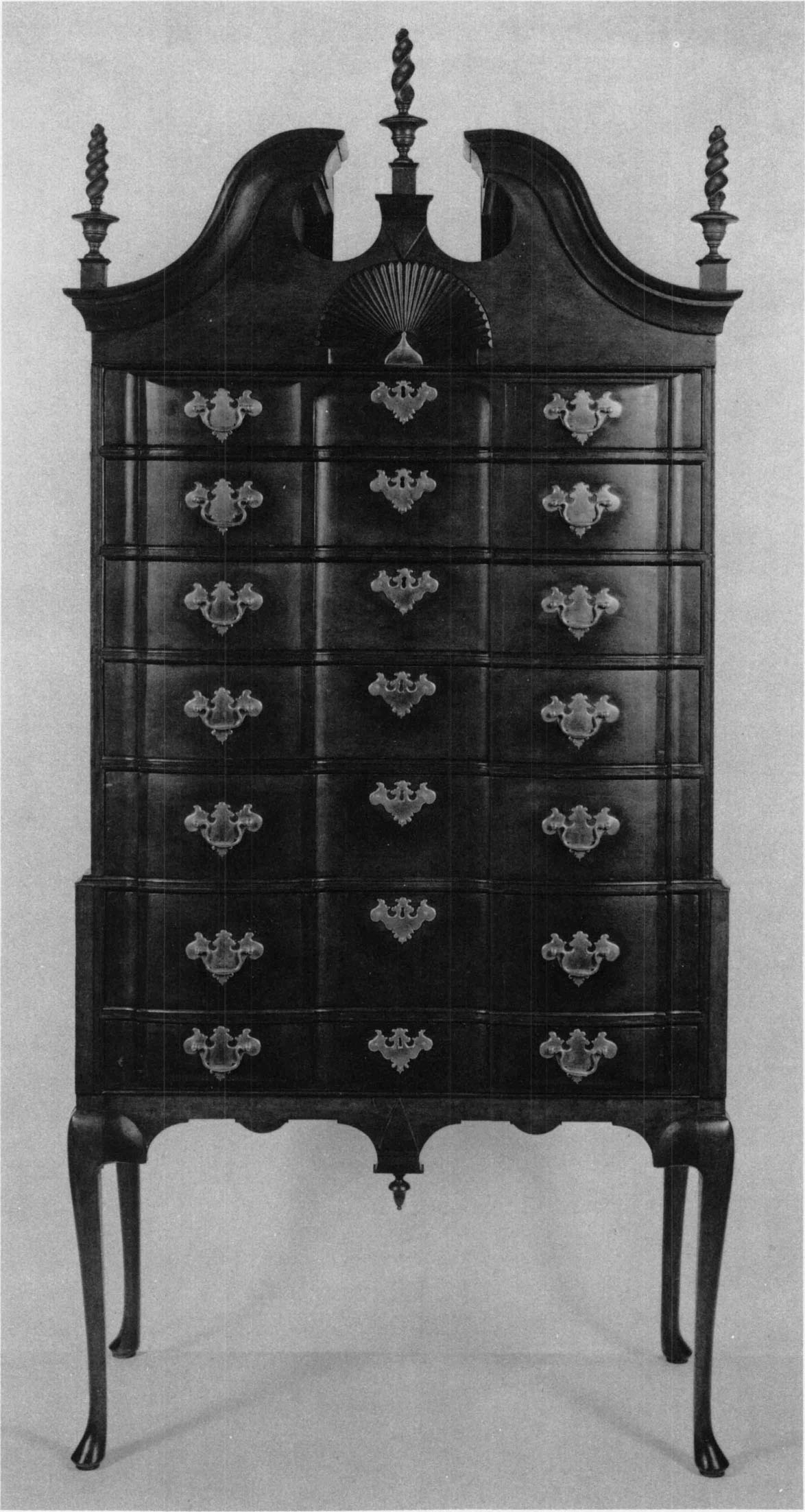
90. High Chest. Attributed to Joseph Hosmer, Concord, Massachusetts, c. 1769. Cherry, maple, and white pine; h. 88 inches, w. 40½ inches, d. 21 inches. (The Henry Francis du Pont Winterthur Museum.) An unusual and inventive design, this rural adaptation of high-style blocking contributed to the worldly show of the Reverend William Emerson (1743–1776) in his Concord home now known as “The Old Manse.”
This survey of blockfronts attests to the vitality, diversity, and longevity of this form in the Boston area. From the 1738 Job Coit desk and bookcase through the developments of Joseph Davis, Abraham Watson, Nathaniel Treadwell, Benjamin Frothingham, Henry Rust, and Joseph Hosmer to the 1778 Quincy desk and bookcase, the fertility of design imagination seldom fails. The style of no single man, the blockfront was made by the polished urban professional and the rural cabinetmaker-farmer. Contemporary patrons from the Wasgatt sisters of Mount Desert, Maine, to the elegant Colonel Quincy of Braintree enjoyed its aesthetic and social attributes. Few other purely decorative design motifs knew such uniformity of principle yet such diversity of application.
Because the blockfronts of Boston antedate those of other regions, it might be assumed that it is from this center that the idea of block-front case furniture spread to Newport, Connecticut, New York, Delaware, and Virginia. Nowhere except in Newport, however, did the enthusiasm for the form equal that of Boston. Curiously, these handsome, solid, baroque forms appealed to the New England temperament where, it has been thought, pragmatism, “plainness,” and prim modesty prevailed.
The mistaken attribution of Boston blockfronts as Newport products will perhaps cease, yet the curious mystery of the source of the blockfronts continues. Nothing precisely like the style of blocking as it is known in this country has been found abroad. Undulating façades are often found on French furniture of the late seventeenth and eighteenth centuries, but the focal point is generally an advanced pavilion rather than a recessed niche. German and Spanish eighteenth-century cabinetwork exhibits a wide variety of vertically undulating façades, but these examples are usually undated and are not direct prototypes. England produced some flatly blocked casepieces which exhibit a restraint and understatement of baroque movement similar to American blocking practice. The English desk and bookcase illustrated in figure 73 is not an isolated phenomenon. A small desk with a recessed central panel is similar, and a group of seven or eight British desks and bookcases is known which is related to one (in the Victoria and Albert Museum, London) said to have been bought by Dean Swift in 1710 (fig. 93). The recessed pedestal blocks of this last desk are reminiscent of American work. Unfortunately, even less is known about these European and English examples than about our own products. It is not likely that the mystery will be dispelled here before substantial research has been done abroad.
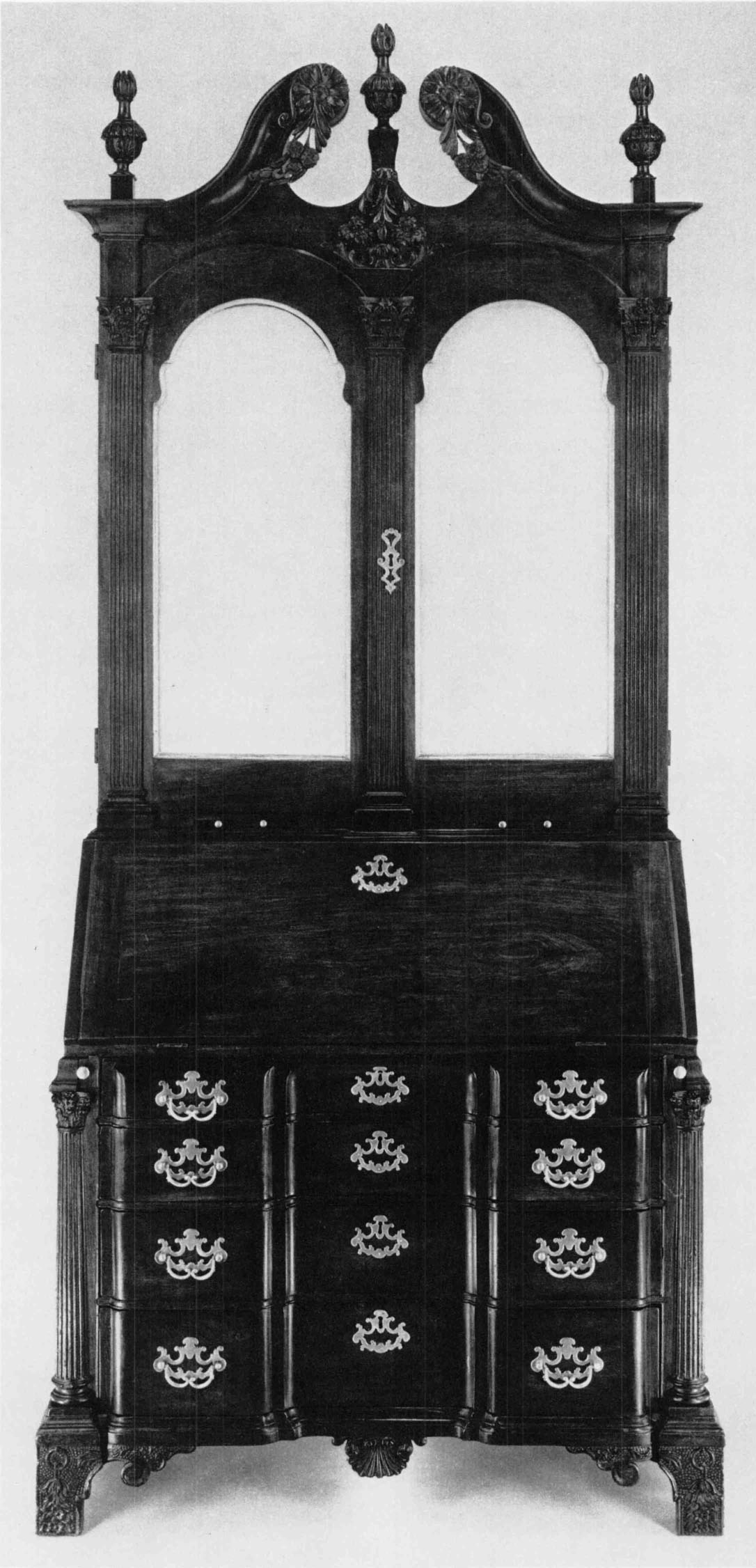
91. Desk and Bookcase. Boston area, 1778. Mahogany, red cedar, and white pine; h. 96⅜ inches, w. 43 inches, d. 23 inches. (The Henry-Francis du Pont Winterthur Museum.) Perhaps the most ambitious and finest of Boston blockfronts, this desk was bought by Josiah Quincy (1710–1784) of Braintree, Massachusetts, in 1778, as the inscription on the desk indicates.
Boston, however, was distinctly the generative center for the creation and practice of the blockfront formula in this country. The groups of examples discussed in this study do not begin to exhaust the list of types and variations of blockfronts produced in the Boston area. By anchoring the discussion in the particular—and where possible the labelled, documented example—I have attempted to suggest (perhaps at the expense of the unique example or completely anonymous group) the general range of production and quality. Underlying the rich variety, however, are certain common design principles, construction techniques, and cultural preferences. The Boston cabinetmakers of the eighteenth century constituted a rich, inventive “school,” and to them should go the credit for formulating and popularizing that significant American experiment in furniture design—the blockfront.

92. Josiah Quincy. Painted by John Singleton Copley, Boston, 1769. Oil on canvas; h. 35¾ inches, w. 28⅜ inches (excluding frame). (Dietrich Brothers Americana Corporation.) A man of taste, Quincy is pictured here seated solidly in a Chippendale chair. The light rococo touches in the lace are reminiscent of the airy carving ornamenting the solid grace of the bookcase.

